Last updated: 7th January 2022
Visiting NASA has been on our bucket list as we’re both a couple of space geeks – Phil has an engineering background and Garth is a huge Sci-Fi fan. So we were super excited to finally visit the Kennedy Space Center! In this guide we’ll show you the 10 best attractions at NASA’s Kennedy Space Center.
Table of Contents
Florida’s Space Coast
Located on Florida’s ‘Space Coast’ the Kennedy Space Center proved to be an easy day trip from our base in nearby Orlando. It’s just 42 miles and takes about an hour to drive, the motorway has a toll but our hire car included the SunPass toll so you can whizz through the express lane.
The Kennedy Space Center is just North of Cape Canaveral (even those two words sound exciting!) and drum up memories of us watching live shuttle launches on TV. We love learning new things when travelling and we can tell you the Kennedy Space Center is a real education, as there’s so much to do so be prepared! We’ve listed the main attractions we managed to fit in a day and the best order you should do them when visiting.
10 Best Attractions at NASA’s Kennedy Space Center
1. Kennedy Space Center Bus Tour – Lift Off!
We arrived early (8.30am) after the airport style security we headed straight to the Kennedy Space Center Bus Tour to guarantee ourselves the shortest queue (or lines as American’s call them). Plan to spend around 2-3 hours for the bus tour and the Apollo/Saturn V Center (where the bus tour ends).
The 45 minute bus tour makes you feel the history of America‘s Space Program, as the journey takes you into the restricted areas of NASA and drives past real life working facilities like the legendary and super tall Vehicle Assembly Building. We were lucky enough to get a glimpse inside as the doors were open! It was really difficult to gauge the scale, however we did spot a tiny person in a yellow jacket which helped, this building is enormous!
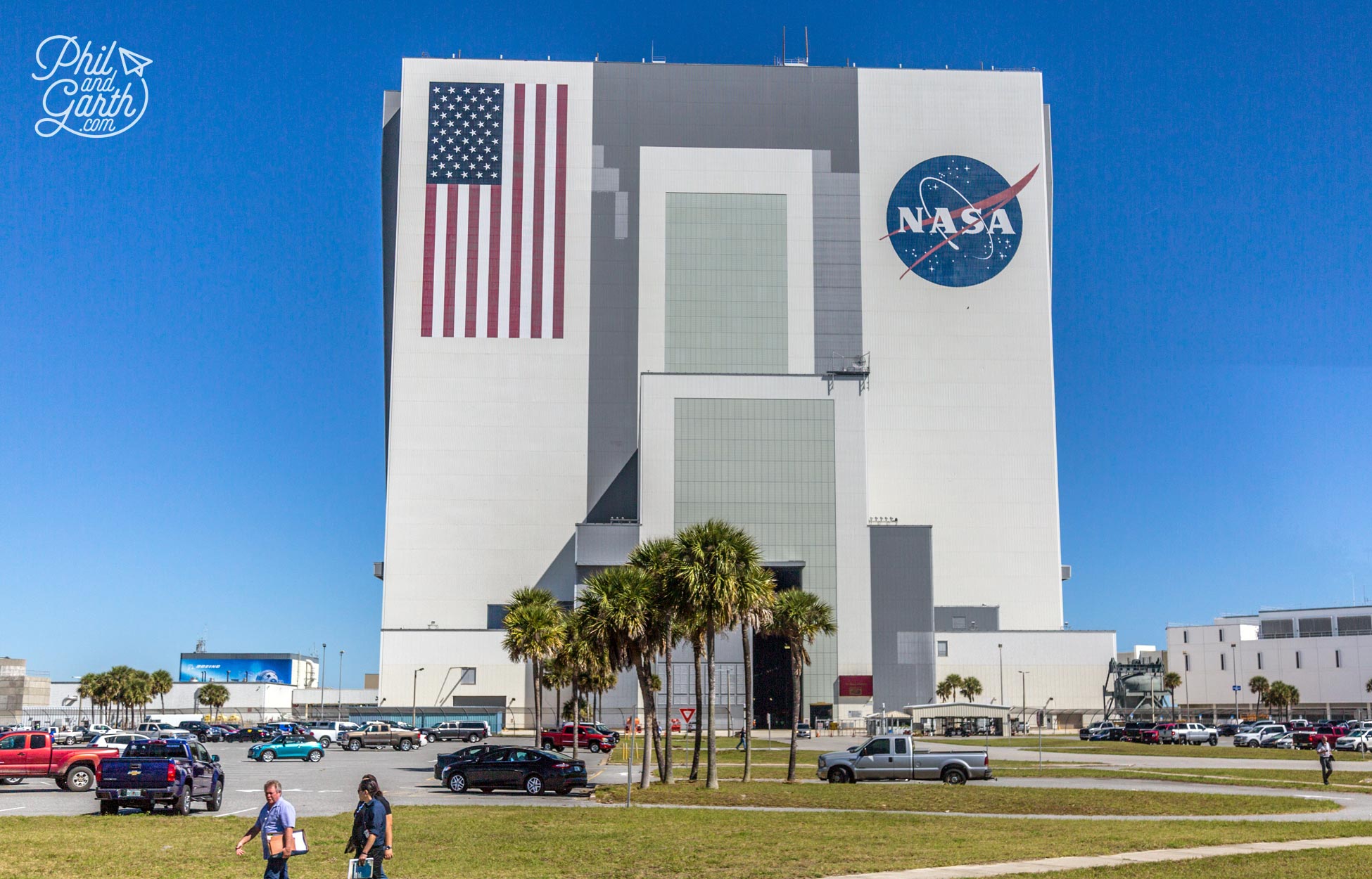
NASA’s enormous Vehicle Assembly Building. It has the world’s biggest doors!
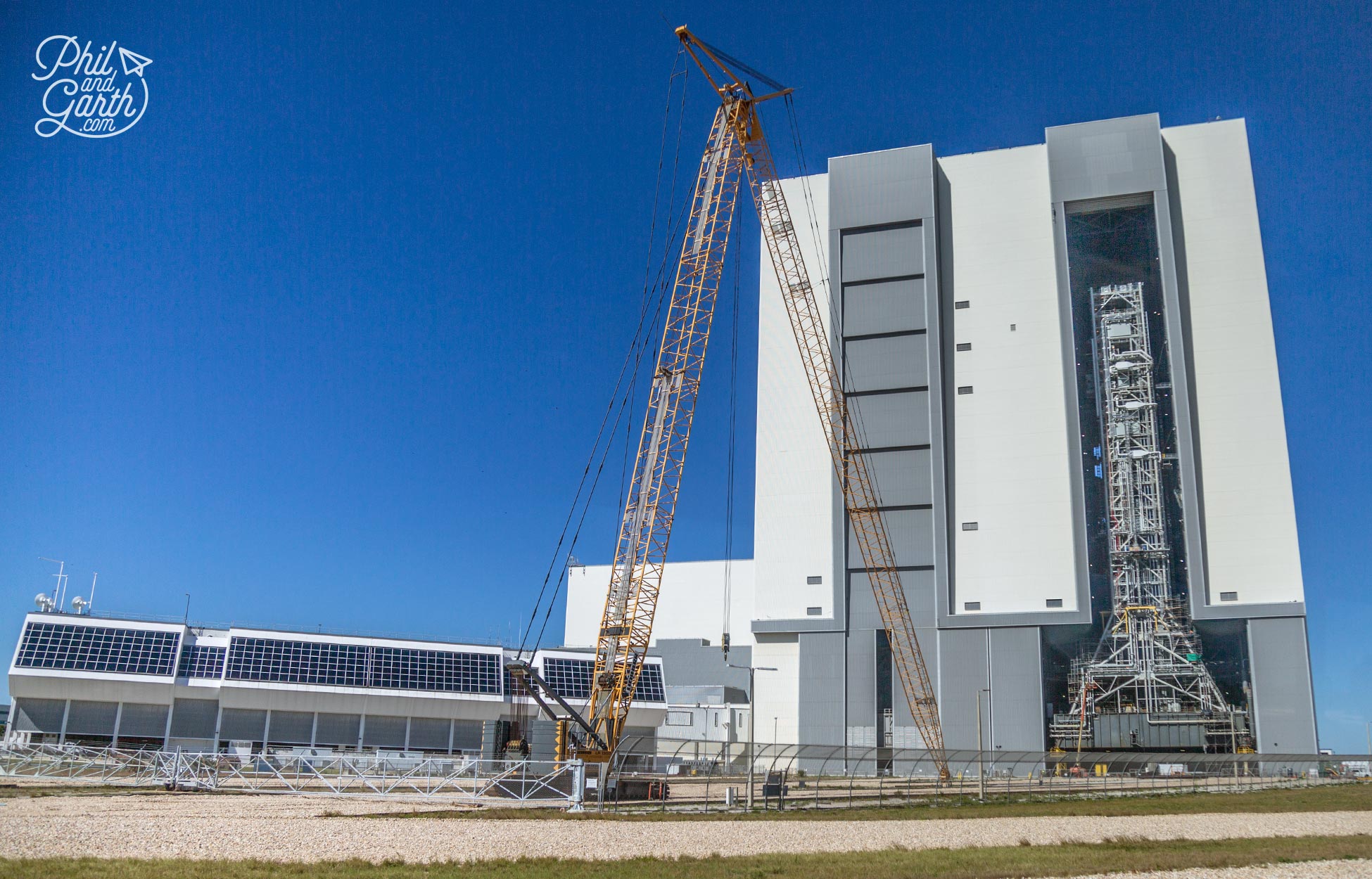
A glimpse inside the Vehicle Assembly Building. On the left are the windows of the Launch Control Center
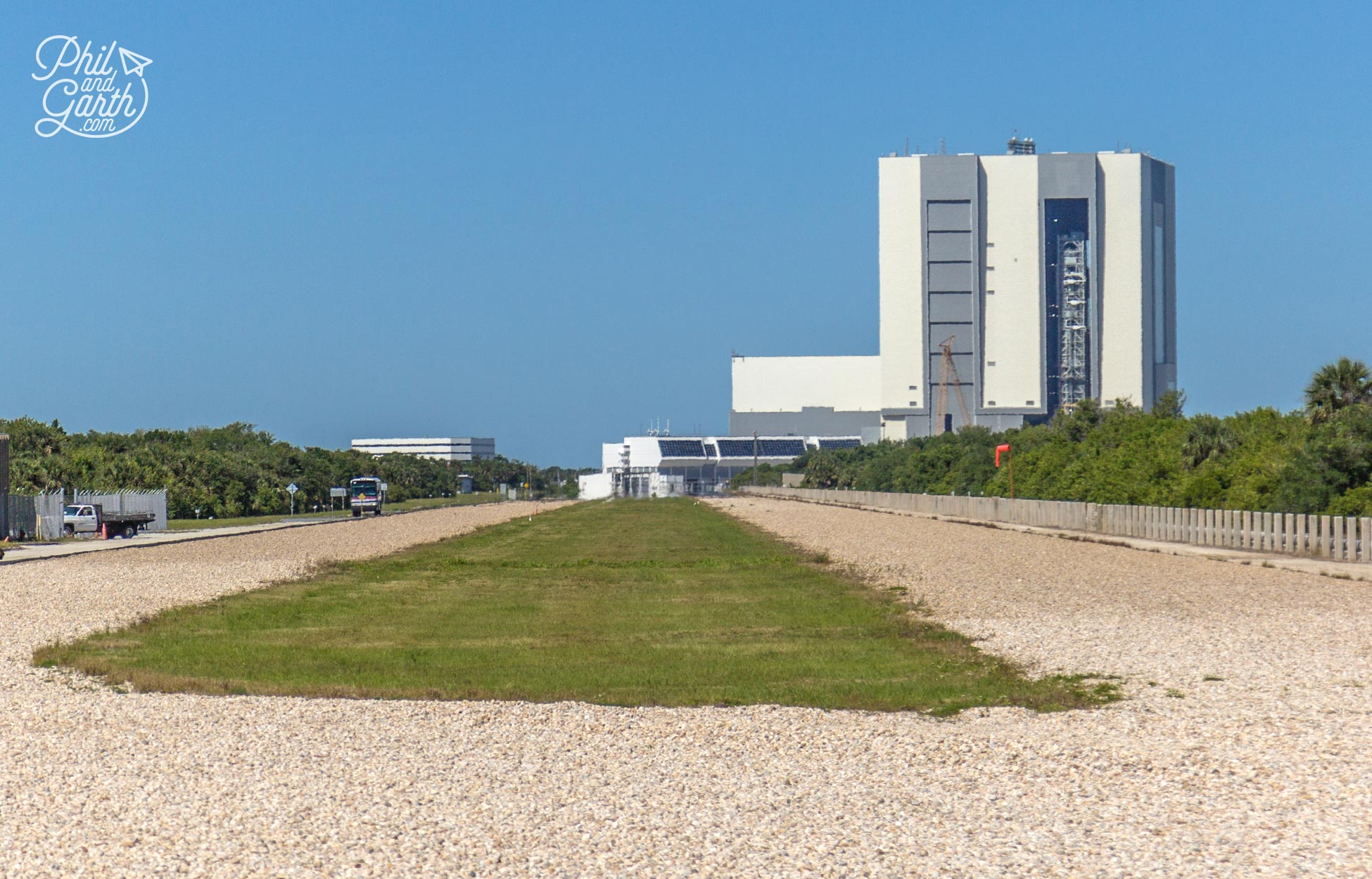
View down ‘Crawlerway’ which connects the Vehicle Assembly building with launch pads 39A & 39B
The Vehicle Assembly Building was built in 1966 for the Apollo Moon Program and later modified for the Space Shuttle Program. It’s part of ‘Launch Complex 39’ which also comprises 2 launch pads – 39A and 39B plus ‘Crawlerway’ – a huge gravel path that was used to transport spacecraft from the Assembly Building to the launch pads.
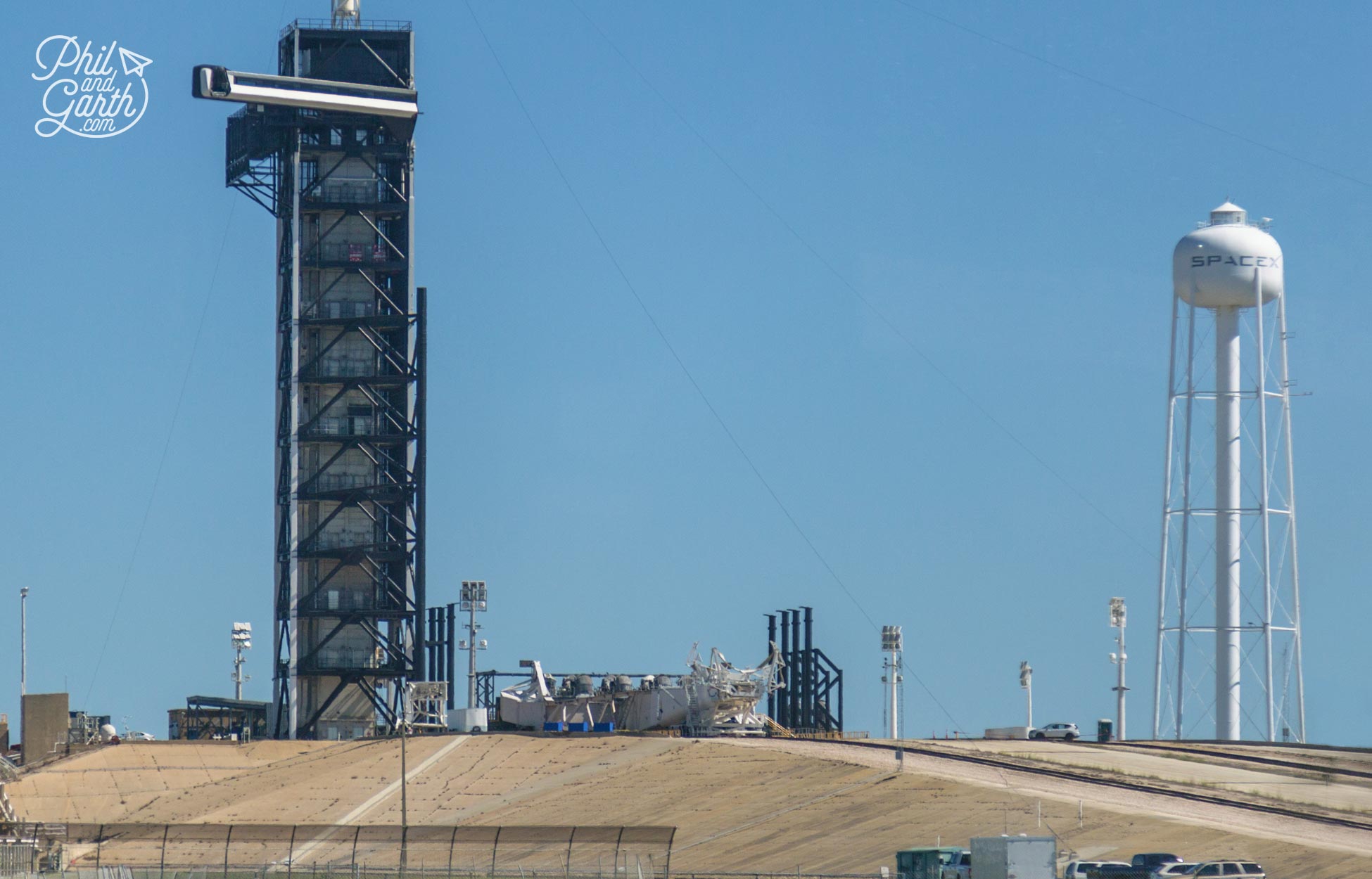
Launch pad 39A is currently leased by SpaceX
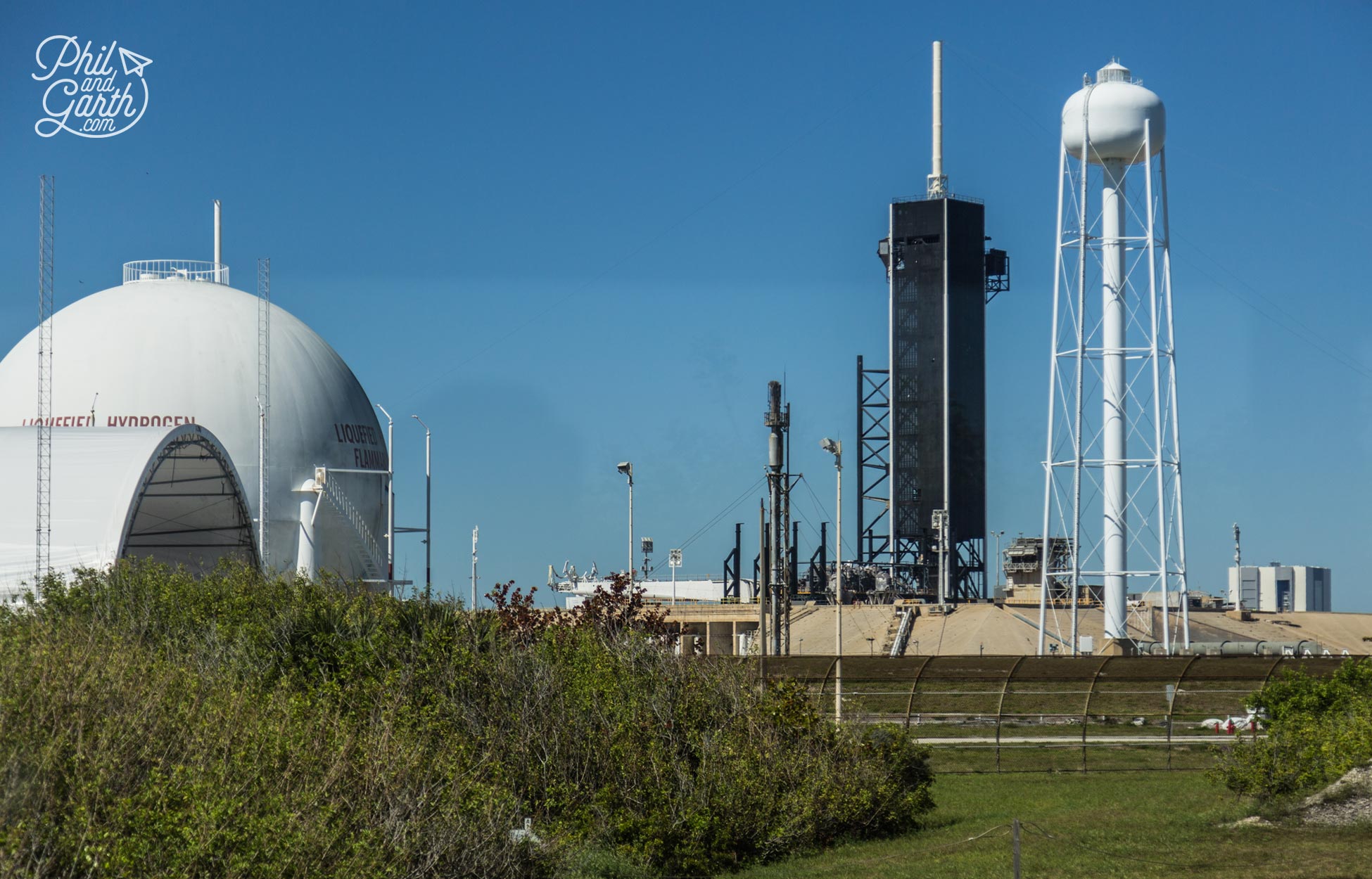
The back of launch pad 39A
Launch pad 39A is currently leased by SpaceX – the space exploration company owned by technology entrepreneur Elon Musk. The pad is used to launch their Falcon X Rockets and Dragon capsules – an unmanned vehicle which takes supplies to the International Space Station. Their long term aim is to send humans to space and test for missions to Mars. Amazing to think this was the same platform used to launch Apollo 11 in 1969 to the Moon! The bus tour takes you around the front and the back of launch pad 39A and the SpaceX buildings.
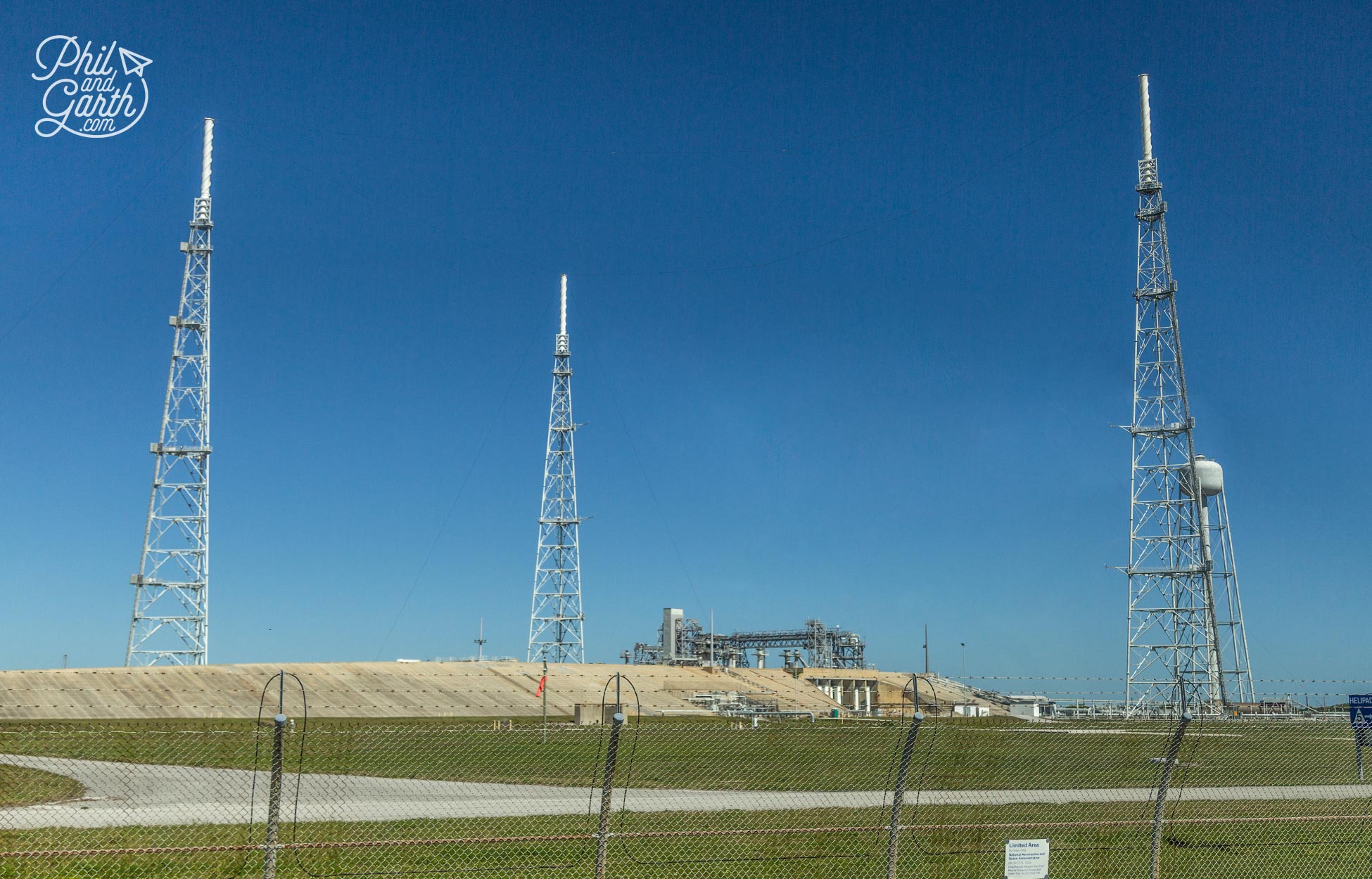
Launch pad 39B – Surrounding the launchpad are 3 steel masts used to protect rockets from lightning strikes.
Launch pad 39B will be used to launch NASA’s next generation of deep space spacecraft for missions to Mars and the Moon using their planned Space Launch System.
There’s great live commentary from the onboard guide, plus some excellent up-to-date videos to watch, our only criticism was sometimes you wanted to looked outside aswell as watching the informative videos.
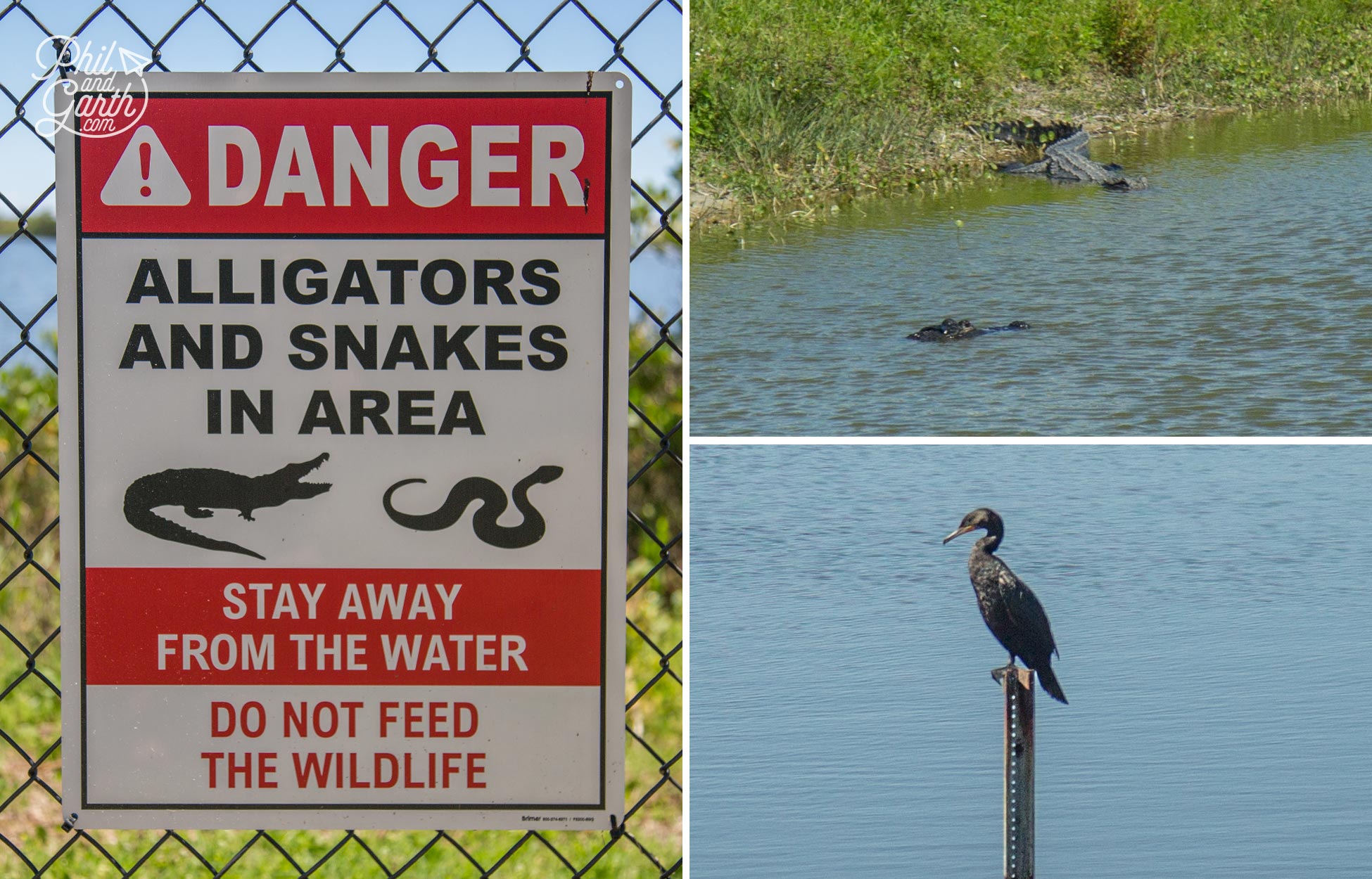
Alligators and wildlife at The Kennedy Space Center
The Kennedy Space Center is also a wildlife preserve so look out for alligators and other wildlife in this area, we saw lots of alligators and some Bald Eagles. When the Space Shuttle used to land here the runway had to be cleared of alligators basking in the sunshine!
NASA chose the previously occupied Cape Canaveral Air Force base and their current location on Merritt Island because of Florida’s closer proximity to the equator. The Earth’s rotation is faster nearer the equator which means it can help slingshot rockets quicker into Space.
2. Apollo/Saturn V Center – The Race To The Moon
The bus tour finishes at the Apollo/Saturn V Center which tells the fascinating story of America’s race to the moon.
The Soviet Union were first to launch a satellite, Sputnik in 1957 and first to put a man into space in 1961, remember this time in history was a fierce competition between the U.S. and Soviet Union – ‘The Cold War’. America was now behind in the ‘Space Race’ and the early success by the Soviets forced President John F. Kennedy in 1963 to announce the Apollo Moon Program – his pledge to land a man on the Moon and return him safely to the Earth by the end of the 1960s. Kennedy’s goal was accomplished on July 20th 1969 when Neil Armstrong and Buzz Aldrin became the first men to walk on the moon.
First up is the story of Apollo 8 in the Firing Room Theatre – where we experienced the thrill of the countdown to the launch of Apollo 8, which was the the first manned mission to orbit the Moon and return to Earth. In front of us are the actual consoles used during the Apollo launches.
As the seconds countdown to the launch the hair stand up on the back of your neck. The whole control room comes to life as screens turn on and flash. Consoles are highlighted by lights as you hear the audio of that section. You experience the excitement and concern that the mission controllers must have felt. You hear the sounds from outside as the whole room shakes and windows rattle with the force of the take off, it’s tense but very exciting!
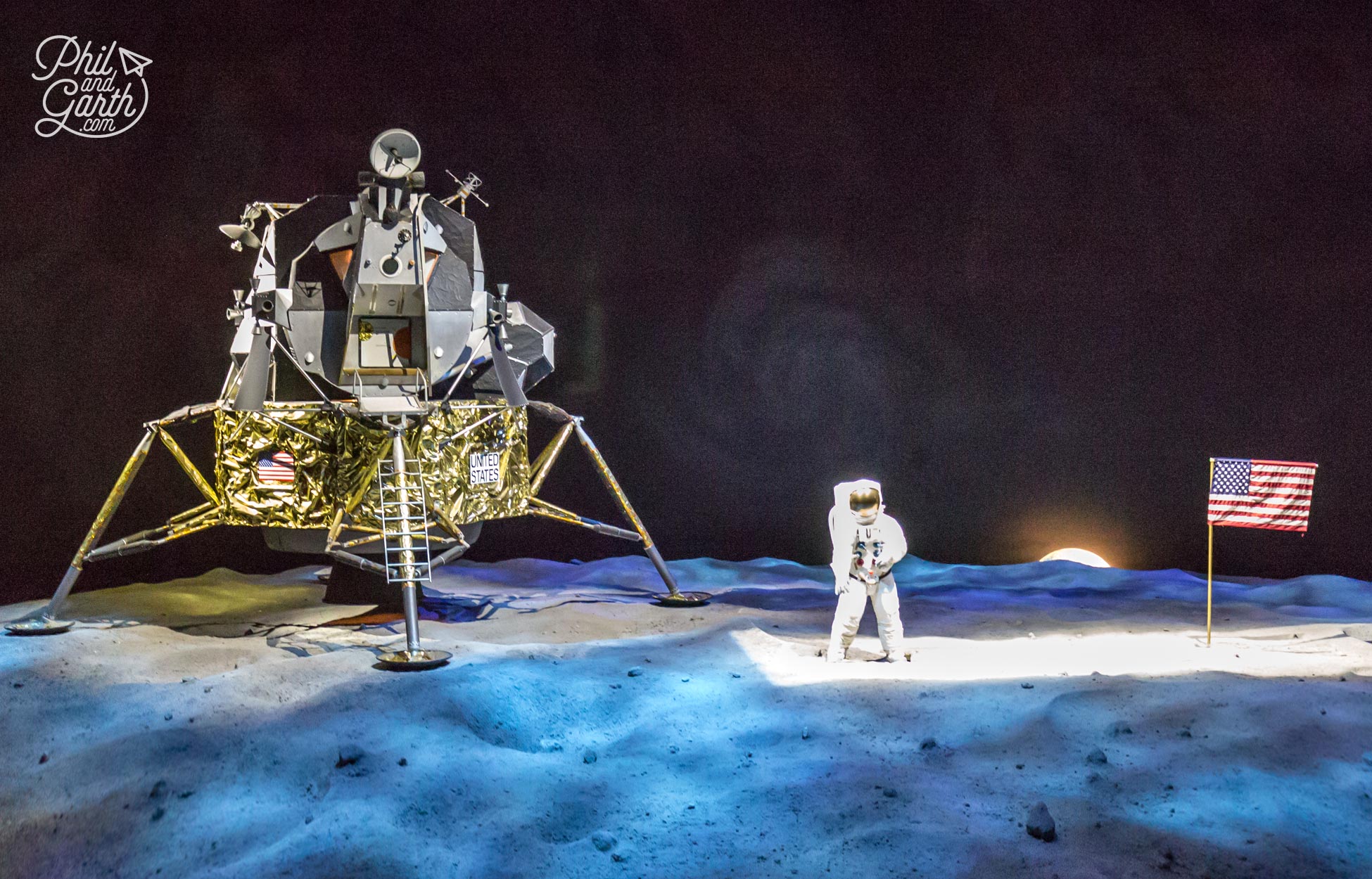
“The Eagle Has Landed” – Relive the final moments of the Apollo 11 at The Lunar Theatre
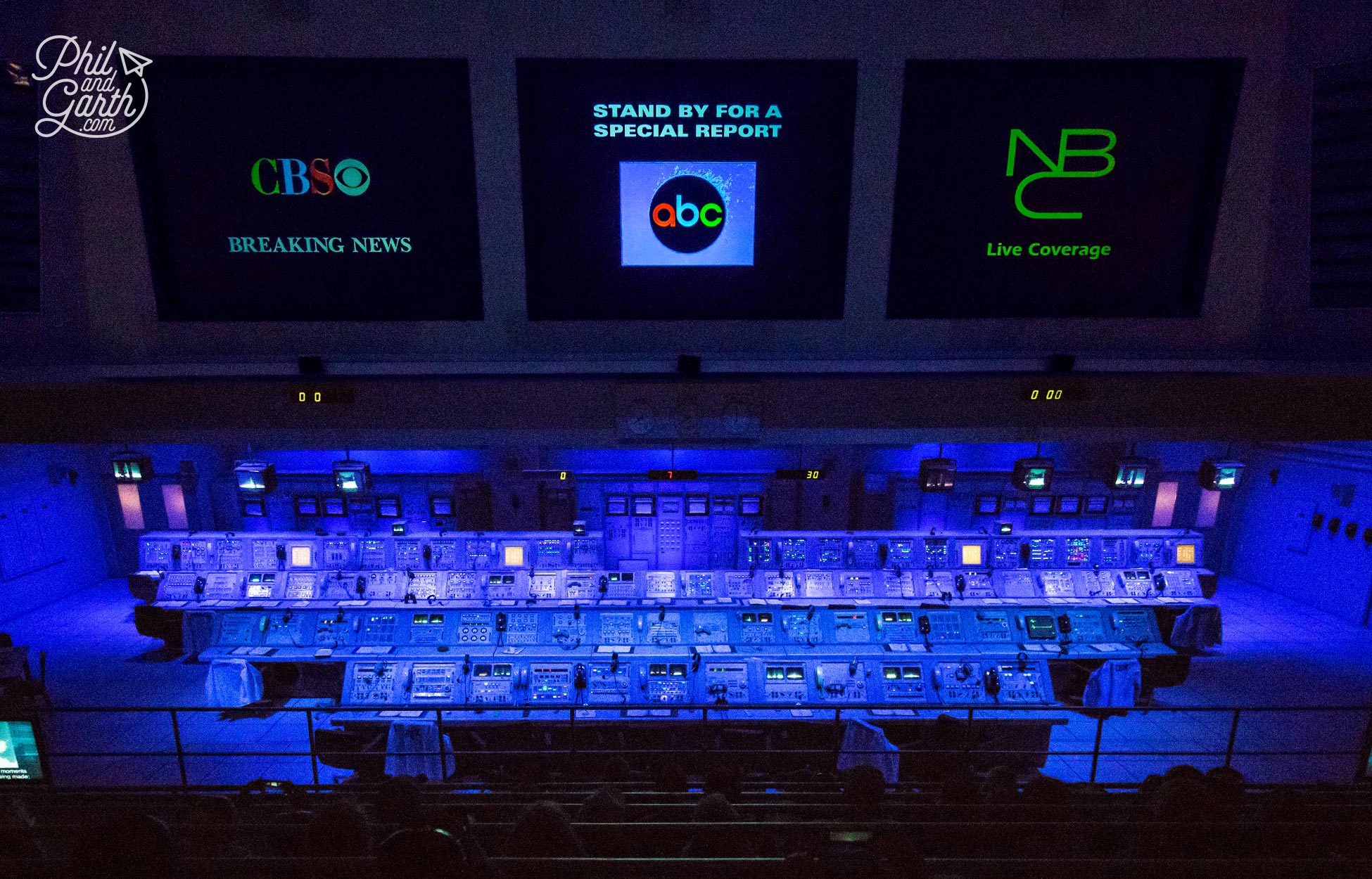
Stand by for the launch of Apollo 8!
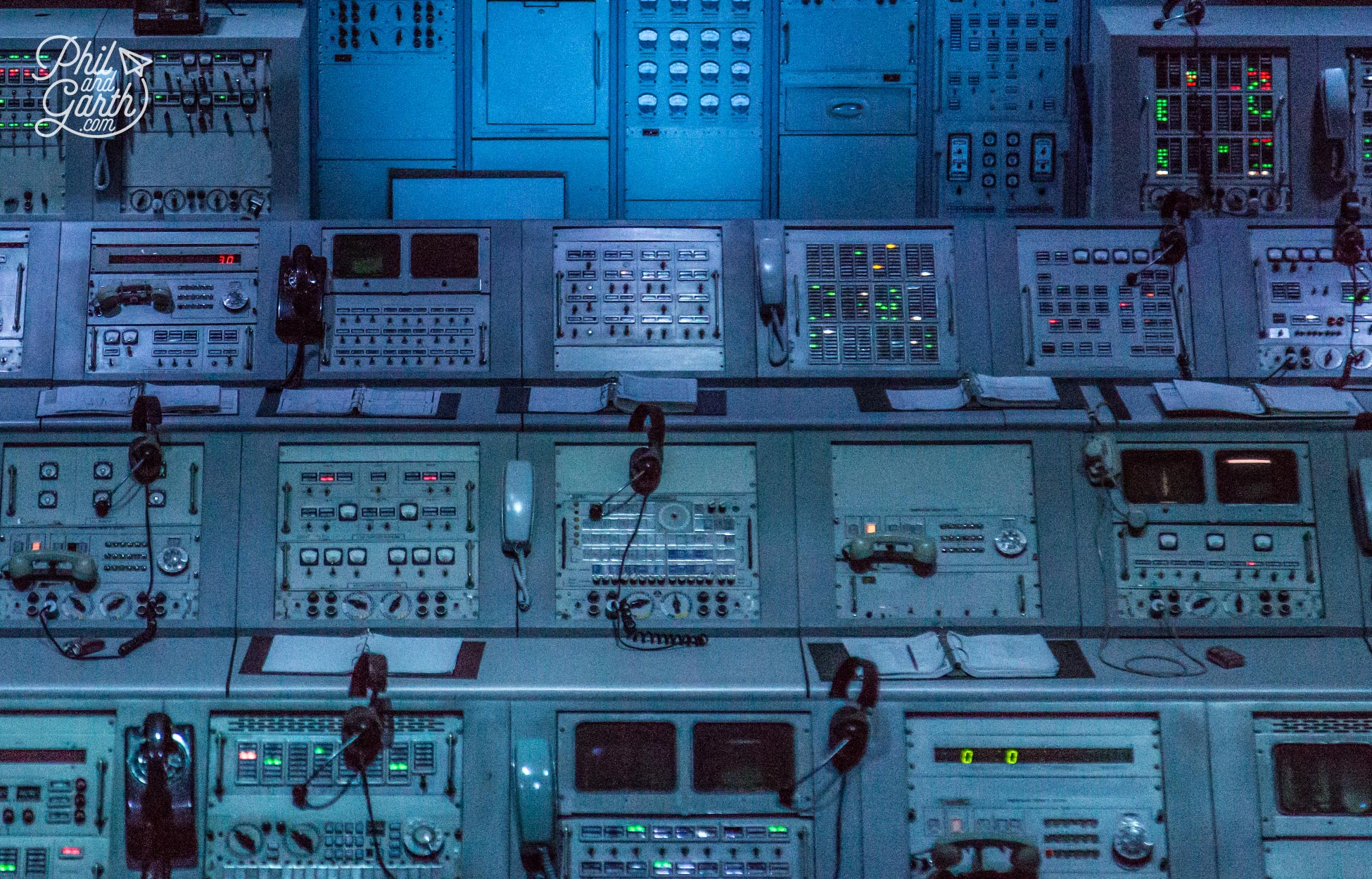
The actual control room consoles used during the Apollo missions
All the Apollo astronaut capsules were placed on top of gigantic Saturn V Rockets. Standing under this giant rocket really is awesome, we walked the length of the largest rocket to ever be flown. It’s massive at 111 metres tall, about 18 metres taller than the Statue of Liberty. In total 13 Saturn rockets were launched, today 3 remain in the USA.
The Saturn V rocket was a three stage design. The 1st stage engines fired for 168 seconds and was able to achieve lift off for about 50 miles. The 2nd stage fired for about 8 minutes to get Apollo through the upper atmosphere at 15,647 mph. The 3rd stage was used for 2.5 minutes to put Apollo into Earth’s orbit and then fired again for another 6 minutes to send Apollo off even faster and further to the Moon.
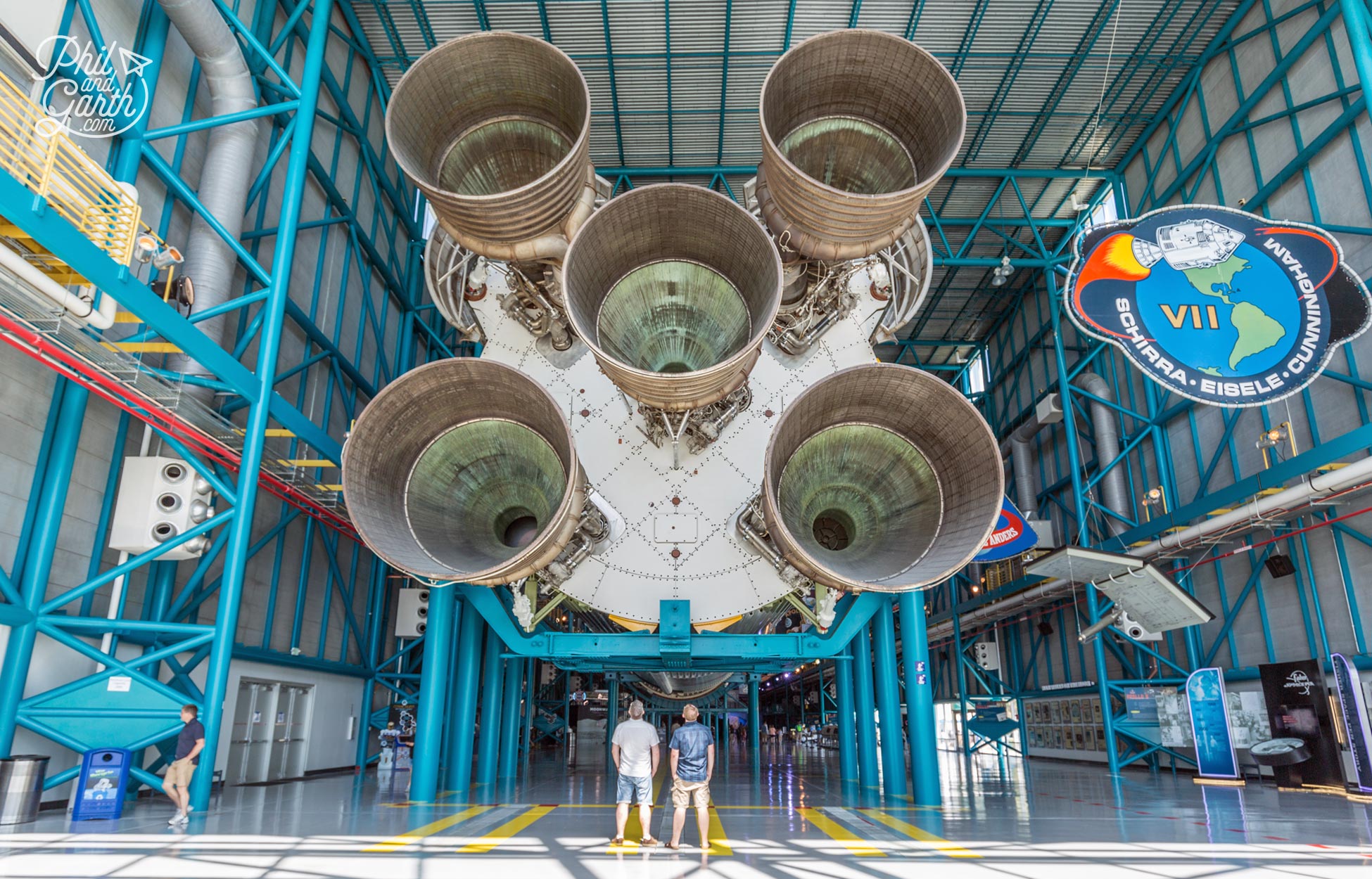
Phil and Garth looking up at the Saturn V Rocket that transferred astronauts to the moon
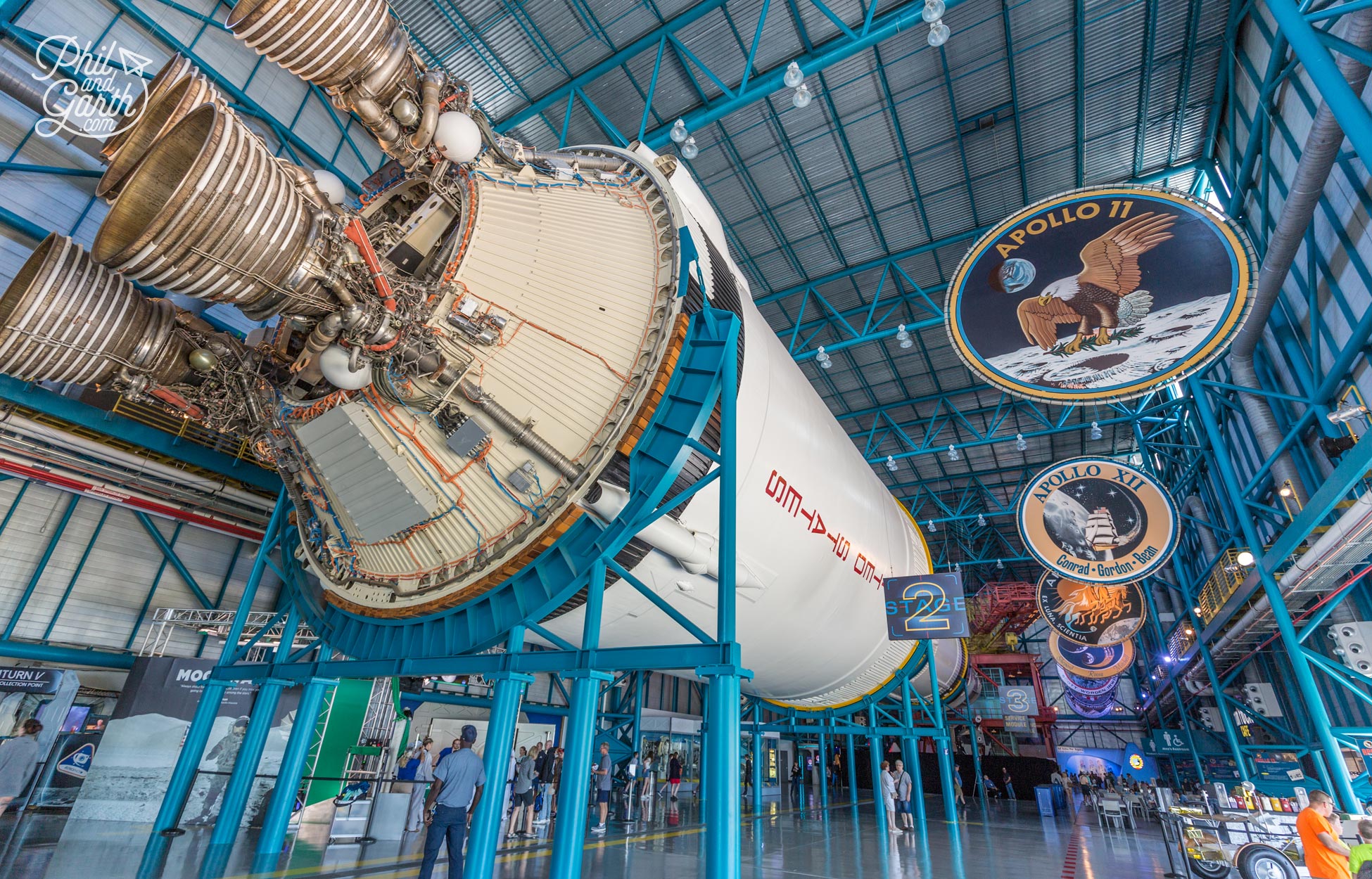
The Saturn V Rocket had a three stage design
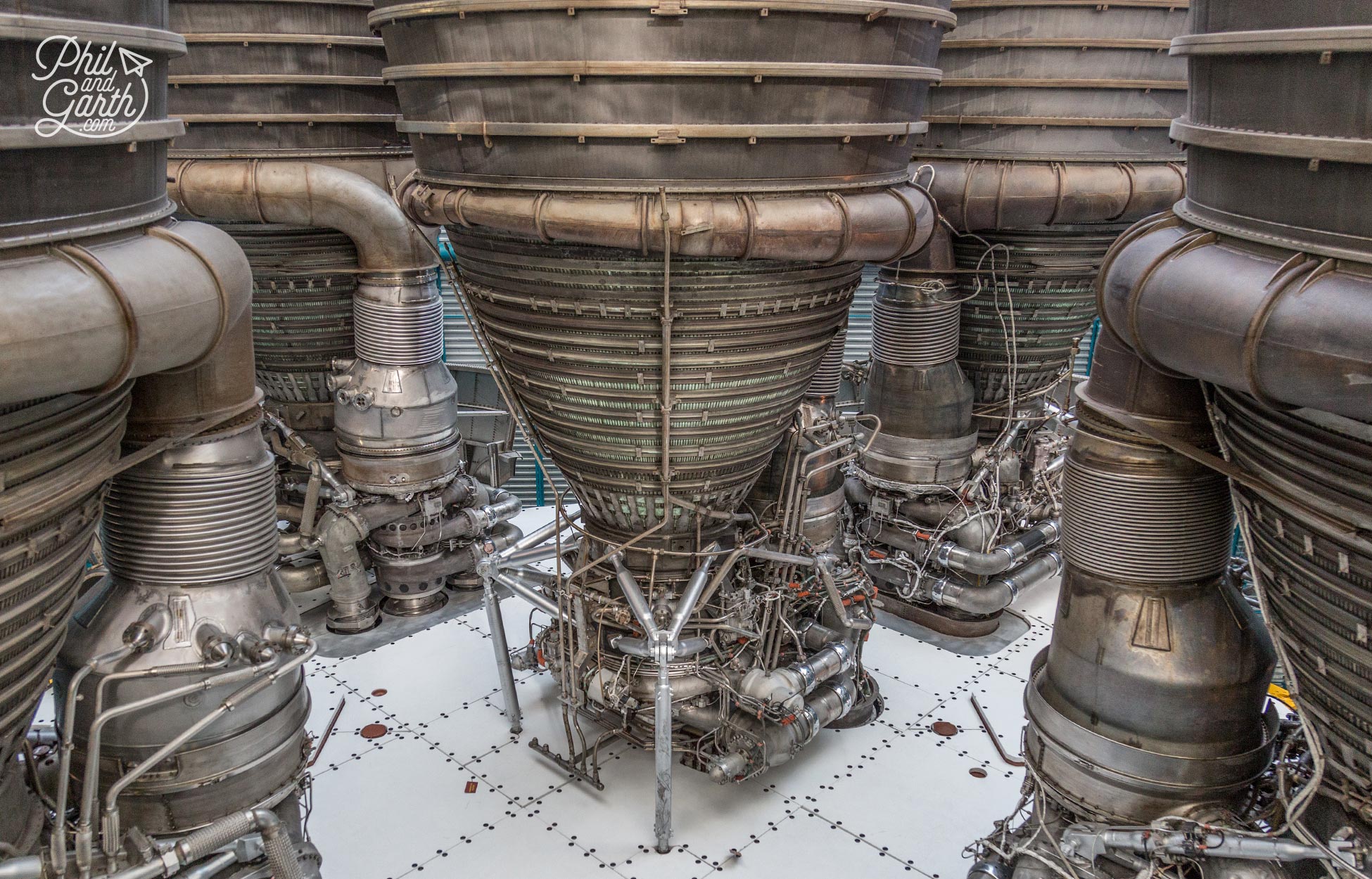
Close up of Saturn V’s 1st stage engines
Learning about the various Apollo missions was fascinating. The most famous was Apollo 11 led by Commander Neil Armstrong and pilots Buzz Aldrin & Michael Collins. We always assumed there was just one moon landing but there was actually a total of 6 crewed landings and a total of 24 astronauts were launched to the Moon. Sadly Apollo 1 ended in tragedy when the 3 astronauts were killed by a flash fire during a launch rehearsal. Apollo 13 nearly ended in disaster after a faulty oxygen tank exploded leaving the astronauts with very little oxygen to get home. The final mission was Apollo 17, which ended in 1972.
What really struck us both looking at all the exhibits in the Apollo/Saturn V Center was how low-tech everything appears. The early astronaut suits look like pieces of nylon sewn together with bits of rubber and velcro strips tacked on, whilst the Lunar Rover looks like some simple kit car you’d put together yourself. But we suppose they were cutting edge at the time and one-offs, things must have been invented on the fly?
It’s really is mind blowing to think of the challenges NASA faced – making space travel a reality and how they achieved it with limited technology and the uncertainty of outer space. What an amazing feat of science, engineering and courage by the astronauts, it must have been very exciting times working at NASA in those pioneering days.
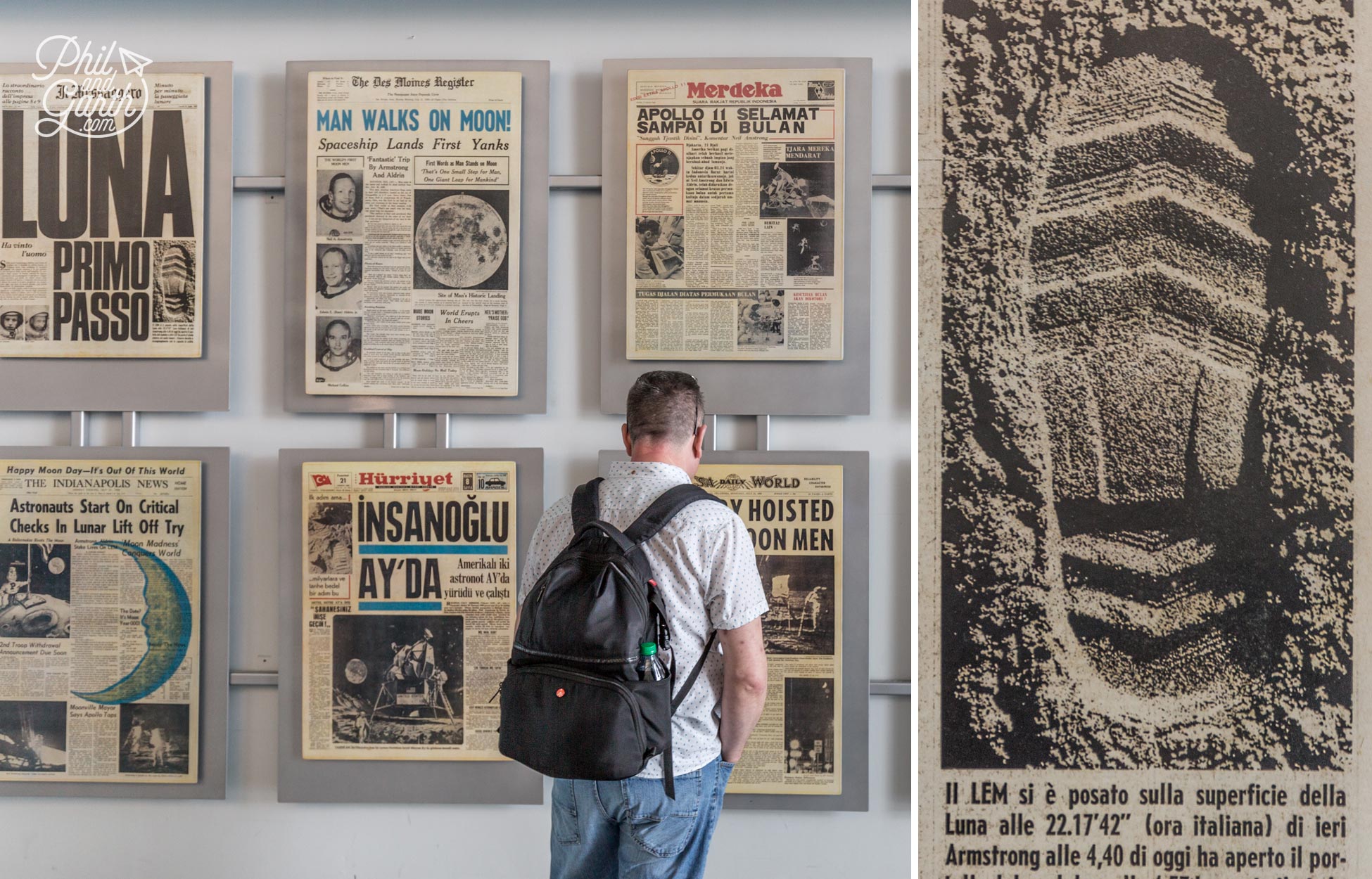
“Man Walks On The Moon!” Phil checks out the worldwide newspaper headlines
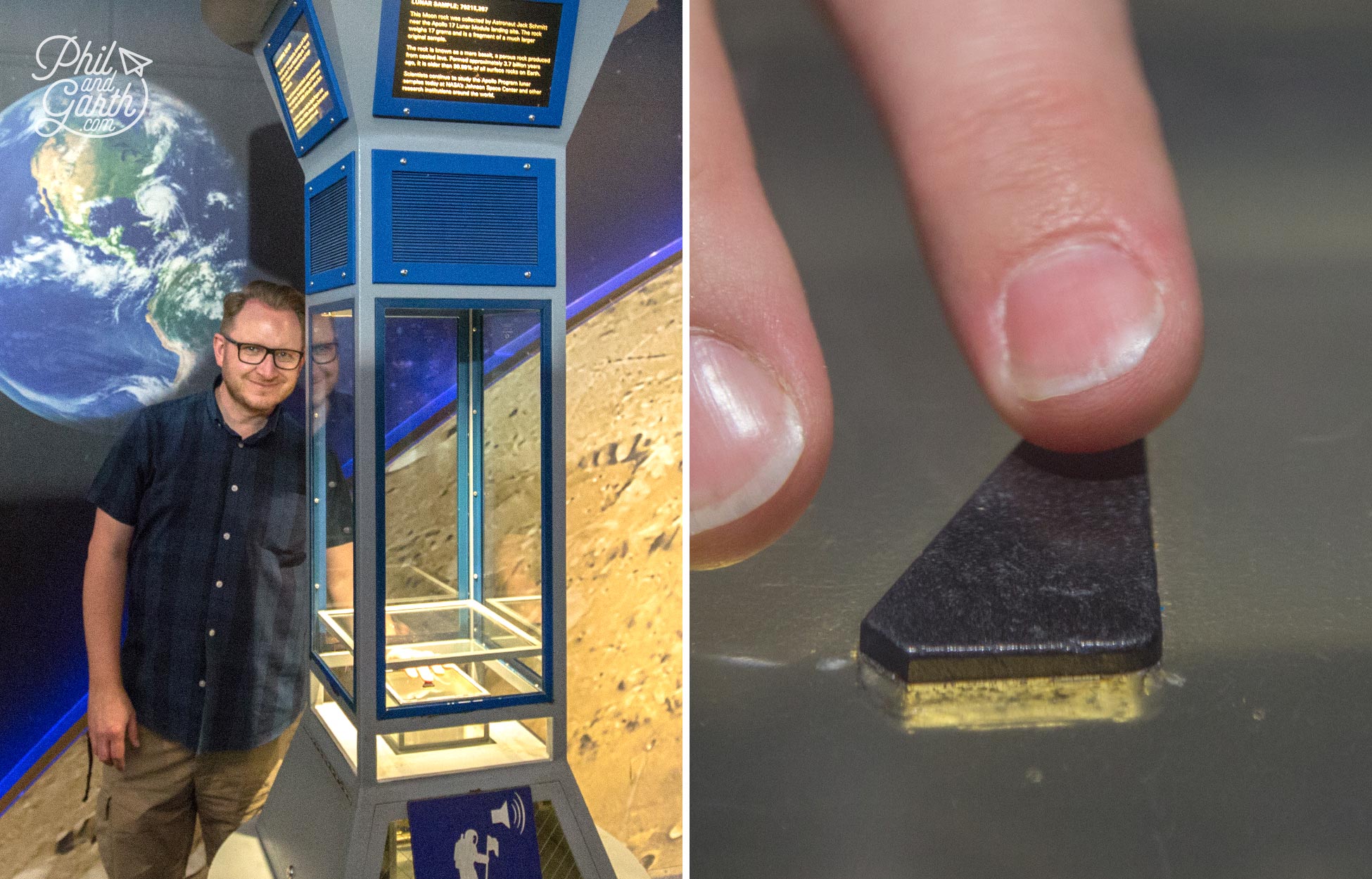
Garth touching an actual piece of moon rock, was it so smooth because of all the visitors touching it?
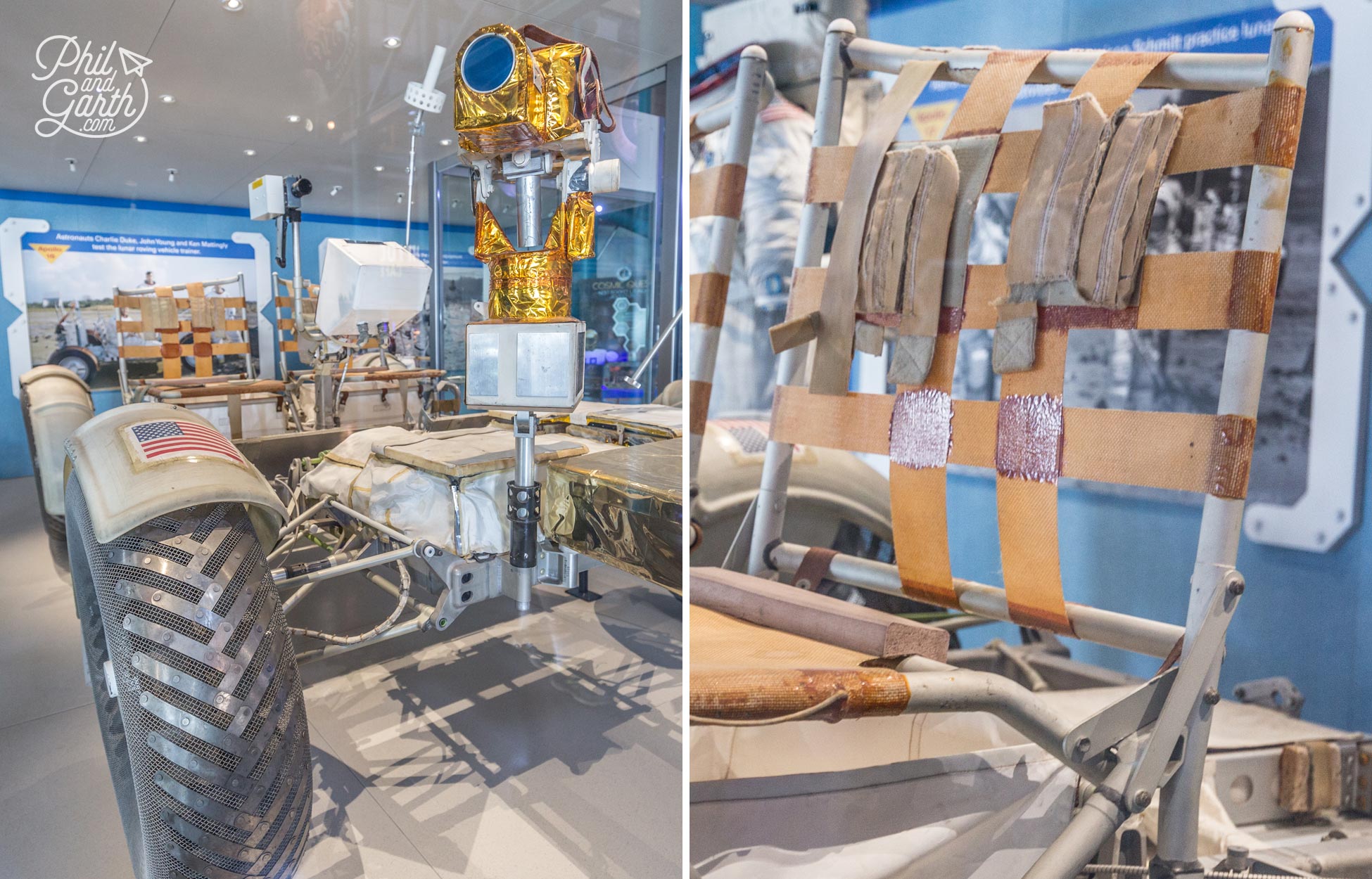
One of the Lunar Rovers used on the Apollo missions
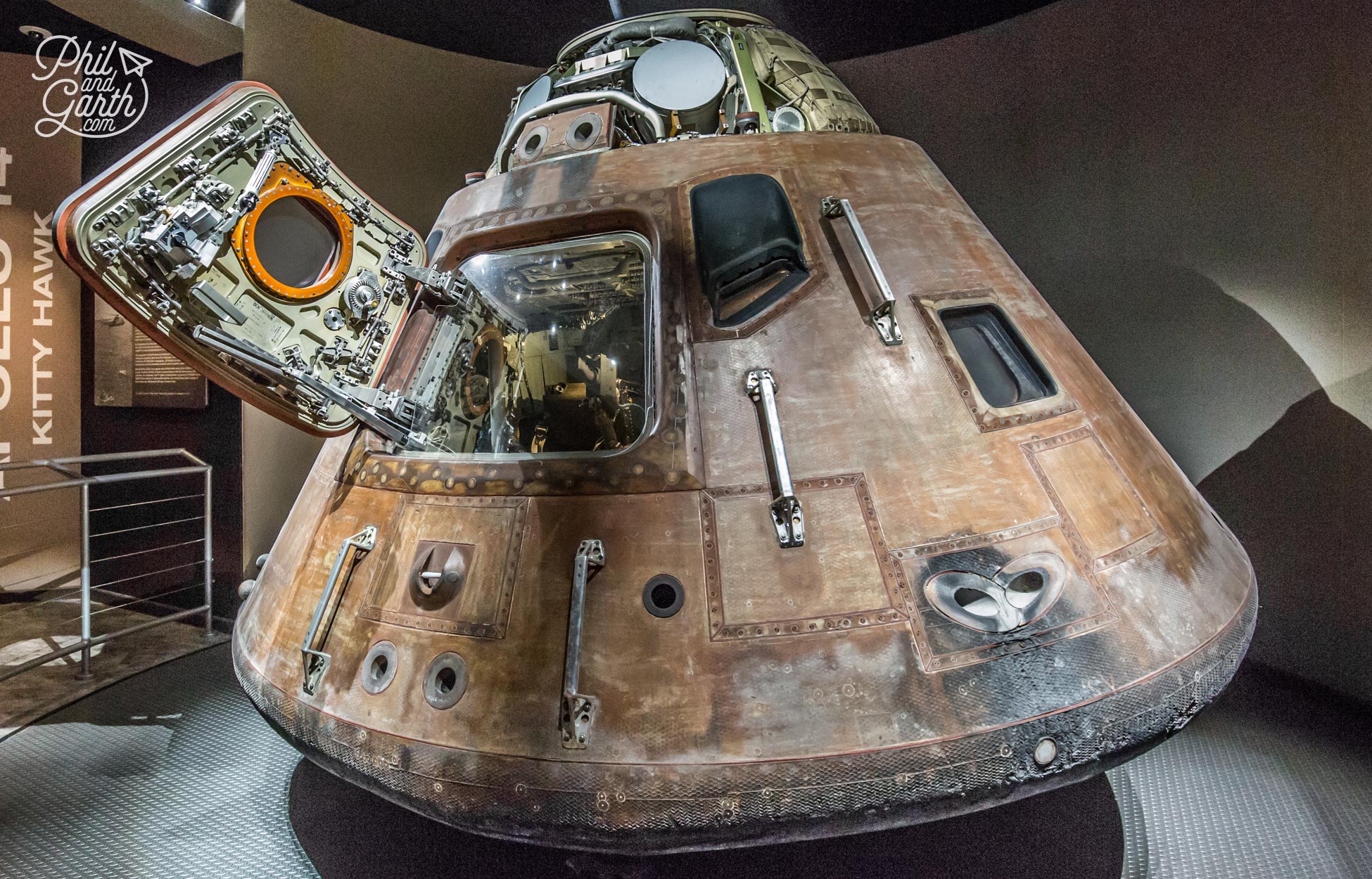
The Apollo 14 command module
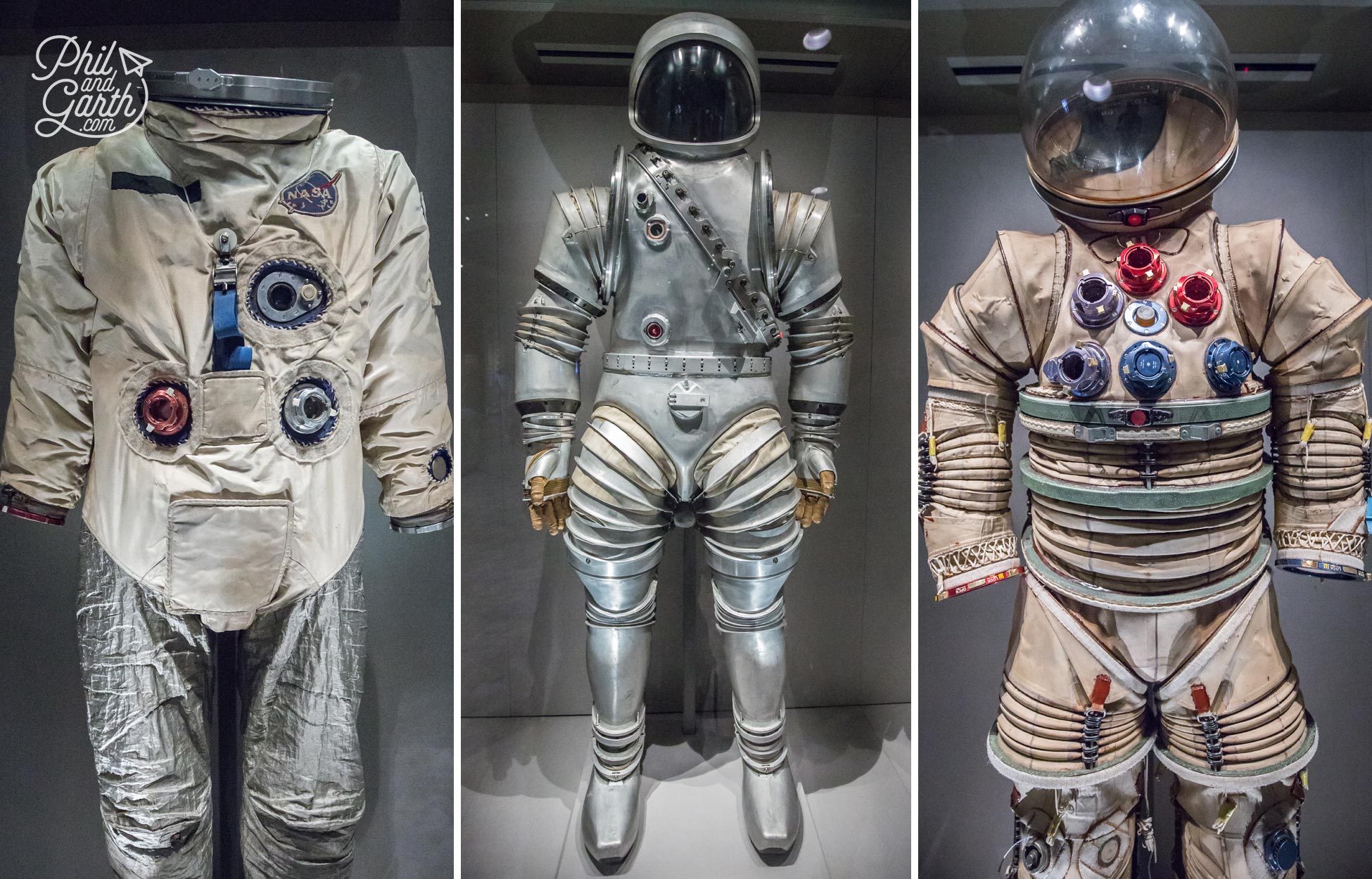
Actual spacesuits worn by astronauts on display in the Treasures Gallery
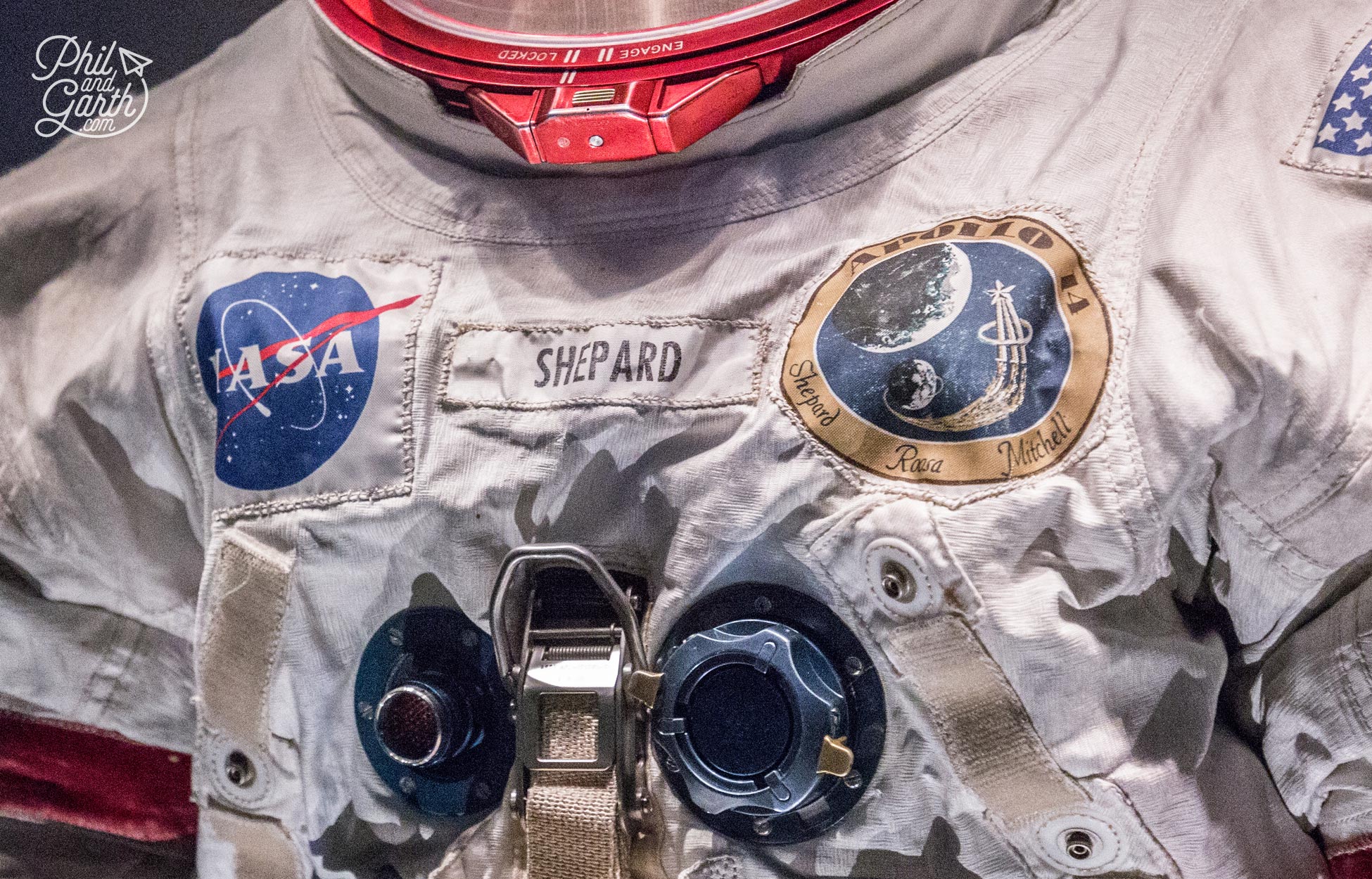
Close up of Alan Shepard’s spacesuit still covered in moon dust
We had lunch here at the Moon Rock Cafe, nothing special just the usual fast-food burgers and chips, but do eat outside where there are great views across to the launch pads and assembly building. To get back to the Kennedy Space Center there are buses that depart every 15 minutes.
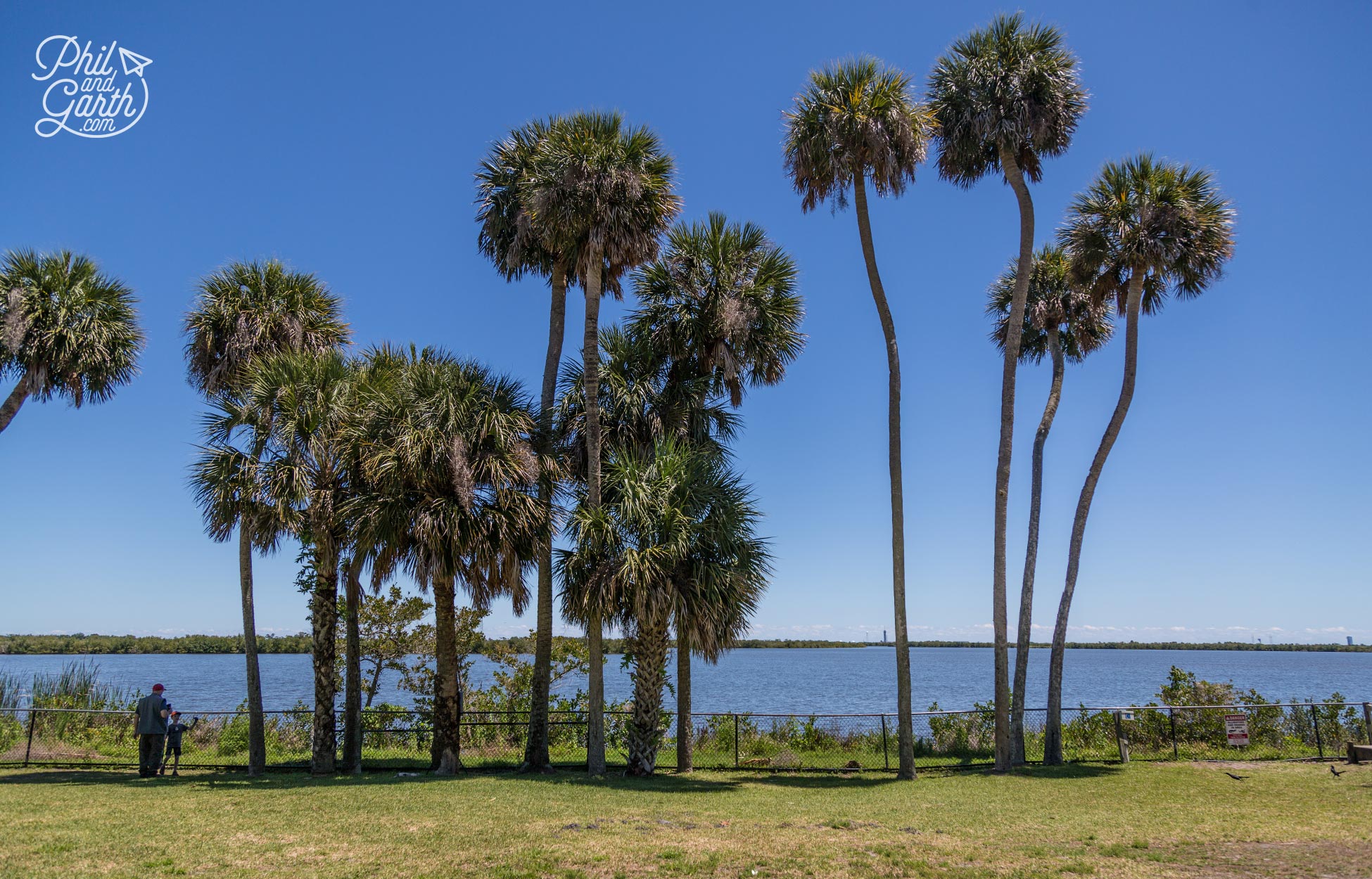
View from the cafe seating area outside
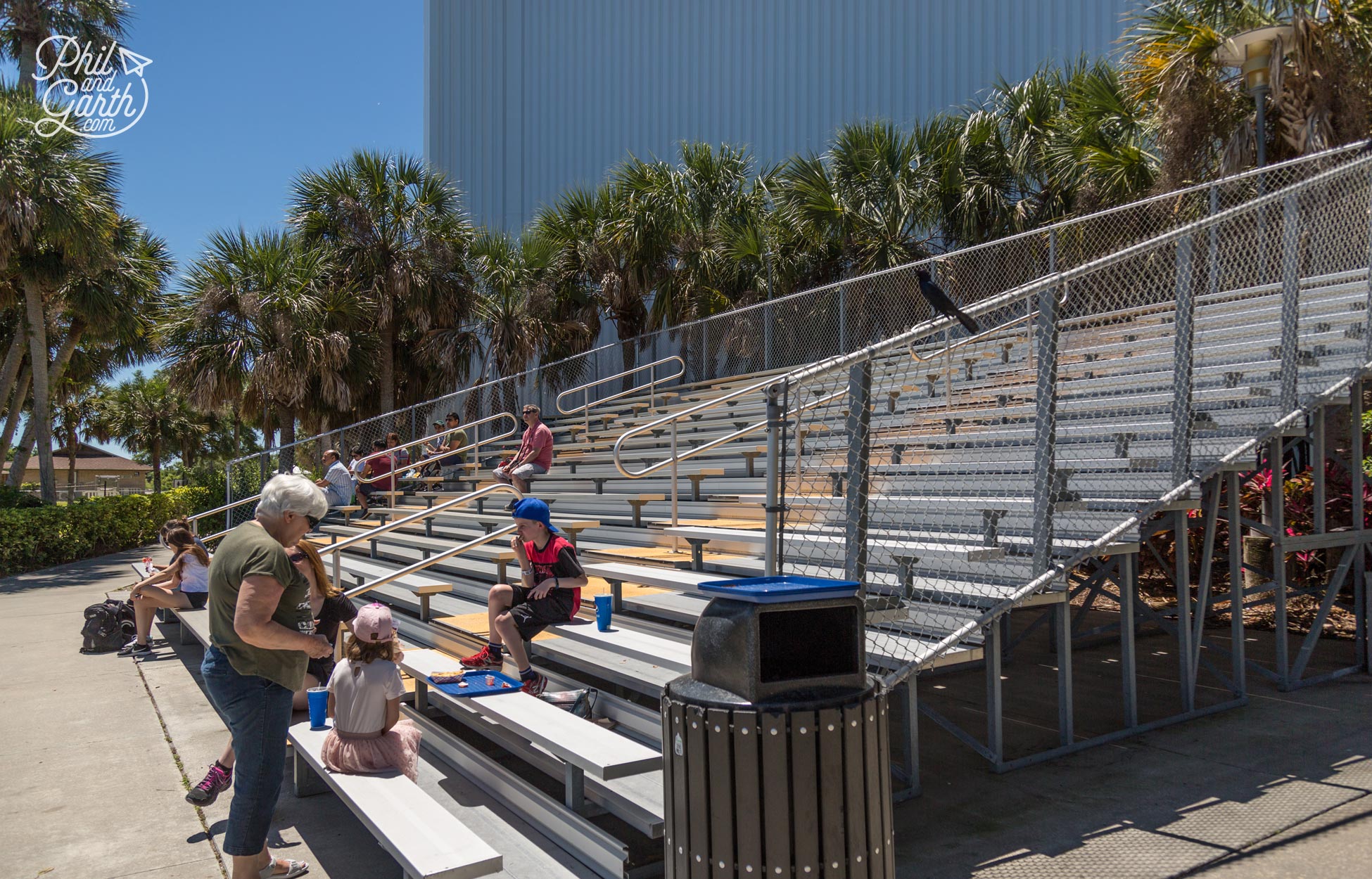
One of the viewing platforms for rocket launches
3. Space Shuttle Atlantis
After a short queue to enter, without doubt Atlantis was our favourite exhibit. It starts with a video telling the story of NASA’s 30 year Space Shuttle Program and the story of Atlantis. We won’t spoilt the reveal to Atlantis because it’s genius and will give you goosebumps! like it did us.
Seeing Atlantis in the flesh is just incredible we were totally awestruck, which doesn’t happen that often. Probably because the Space Shuttles played a part of our generation growing up, we can remember at school being allowed to watch some Shuttle launches in the early 80s on TV. Perhaps we watched the very first shuttle launch of Columbia in 1981?
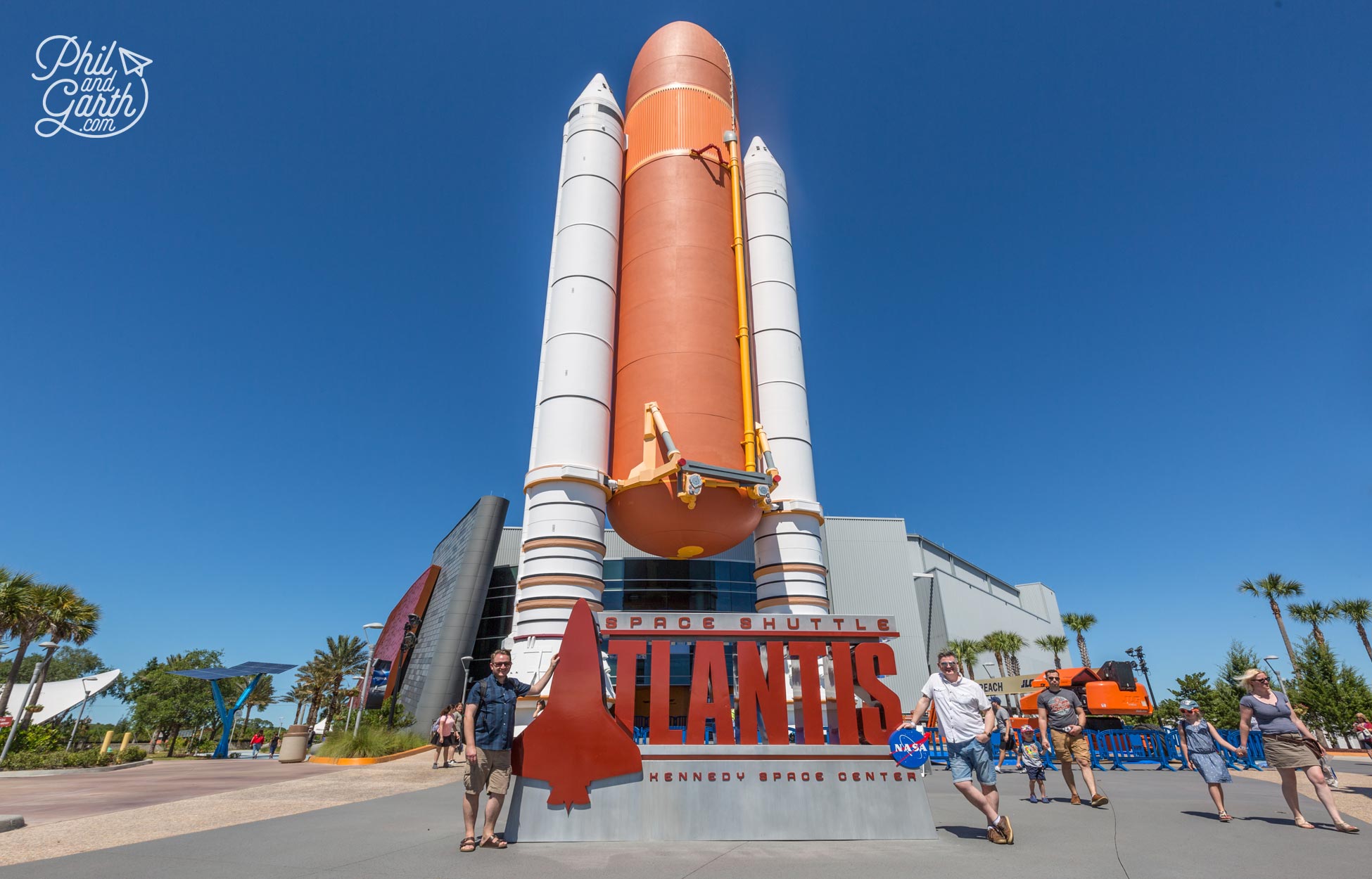
Garth and Phil outside the Space Shuttle Atlantis building
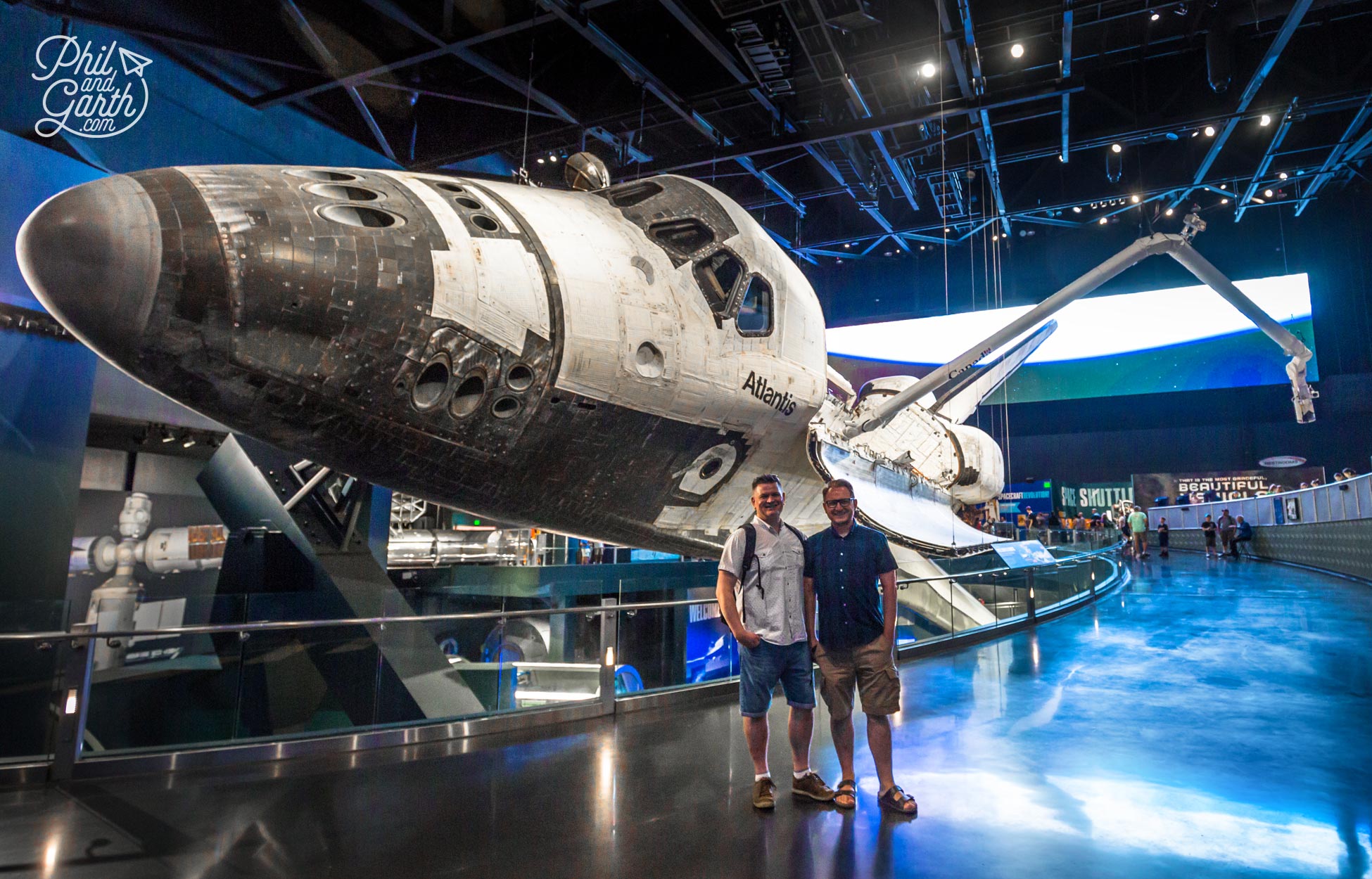
Phil and Garth stood next to Space Shuttle Atlantis
The Space Shuttle was a revolutionary development allowing a spacecraft to be used for multiple trips to and from space. Atlantis was the workhorse of NASA’s fleet, it took 33 missions over 26 years and orbited the earth 4,000 times, it also took astronauts on the very last Space Shuttle flight and mission in 2011.
Atlantis is brilliantly exhibited – suspended in the air at 42.3 degrees as if floating in space with the payload doors open and the ‘Canadarm’ remote-controlled mechanical arm extended. On a side note we laughed at all mansplaining going on here!
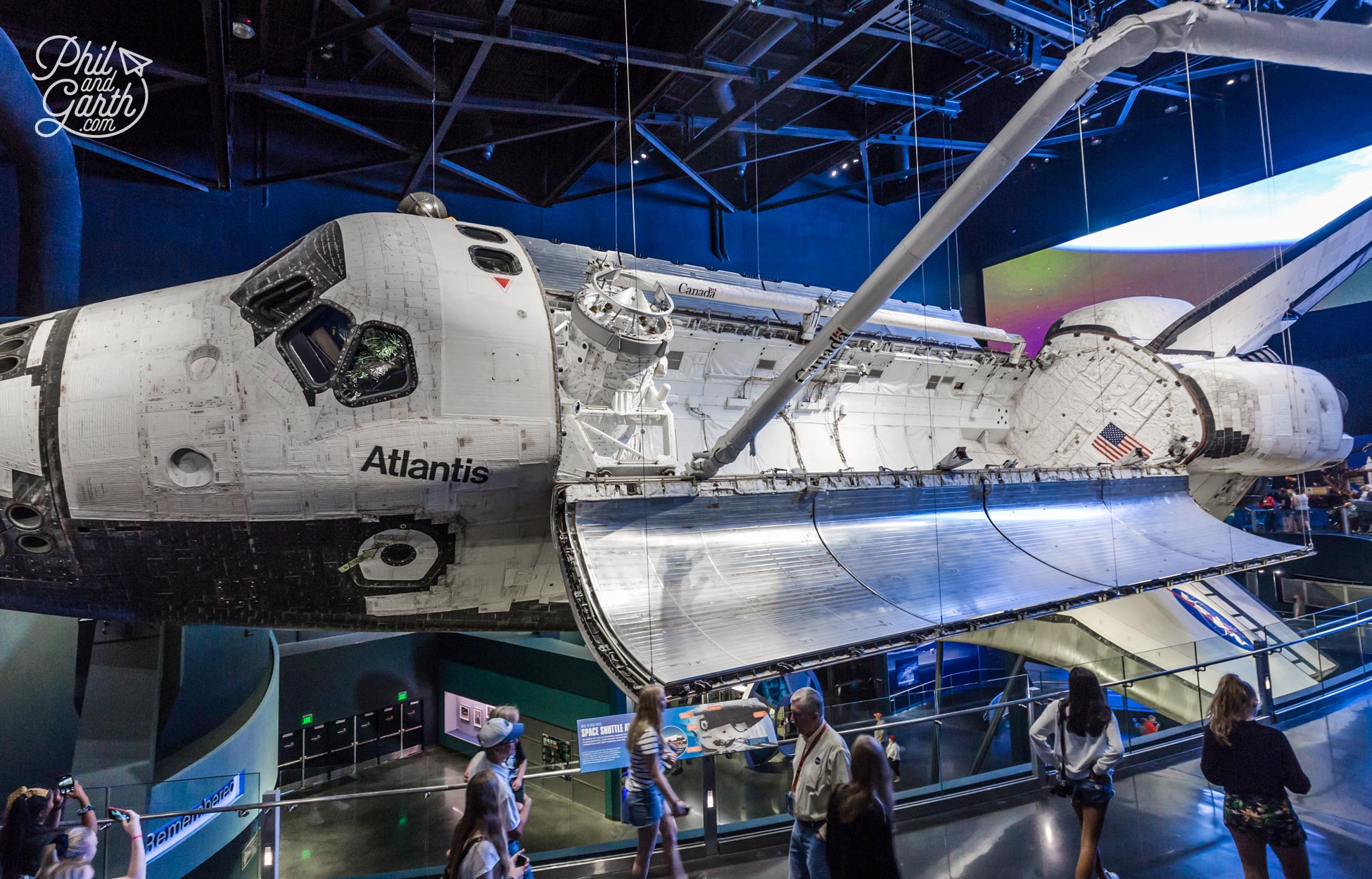
Space Shuttle Atlantis is suspended and angled as if floating in space
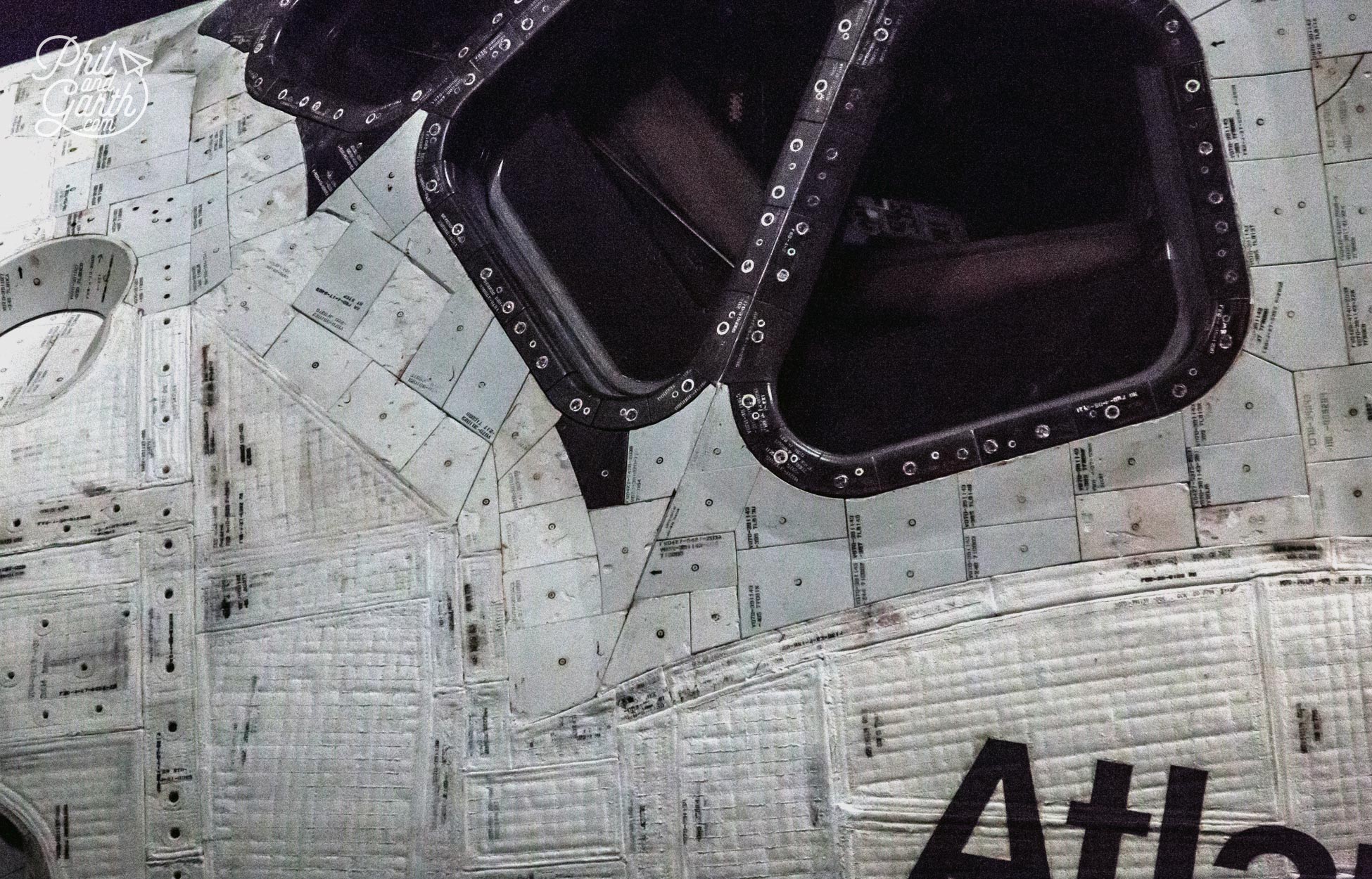
Close up of the white insulation tiles to protect against ultra cold temperatures
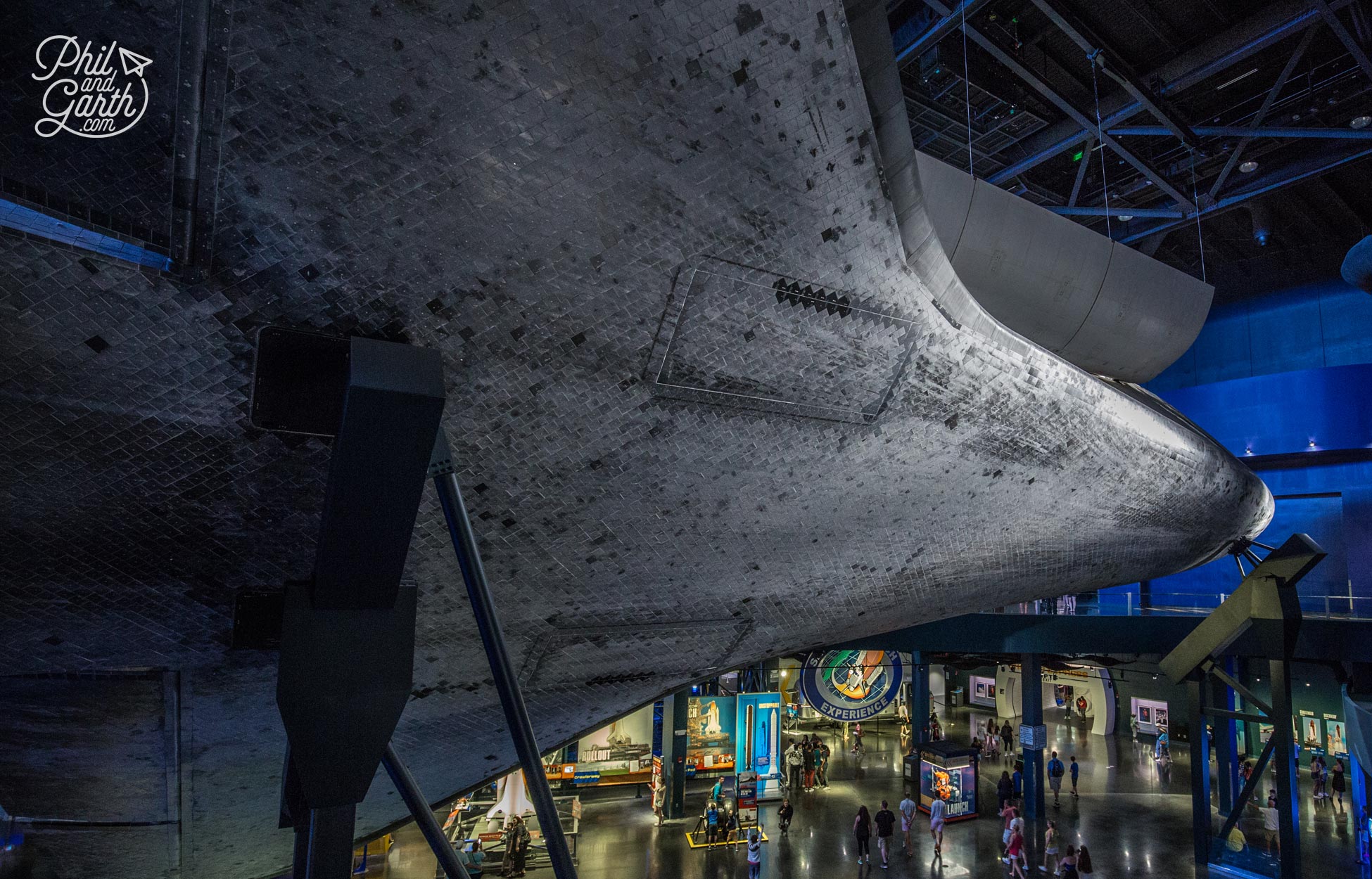
Underside of Atlantis is covered in black tiles to protect against ultra high temperatures
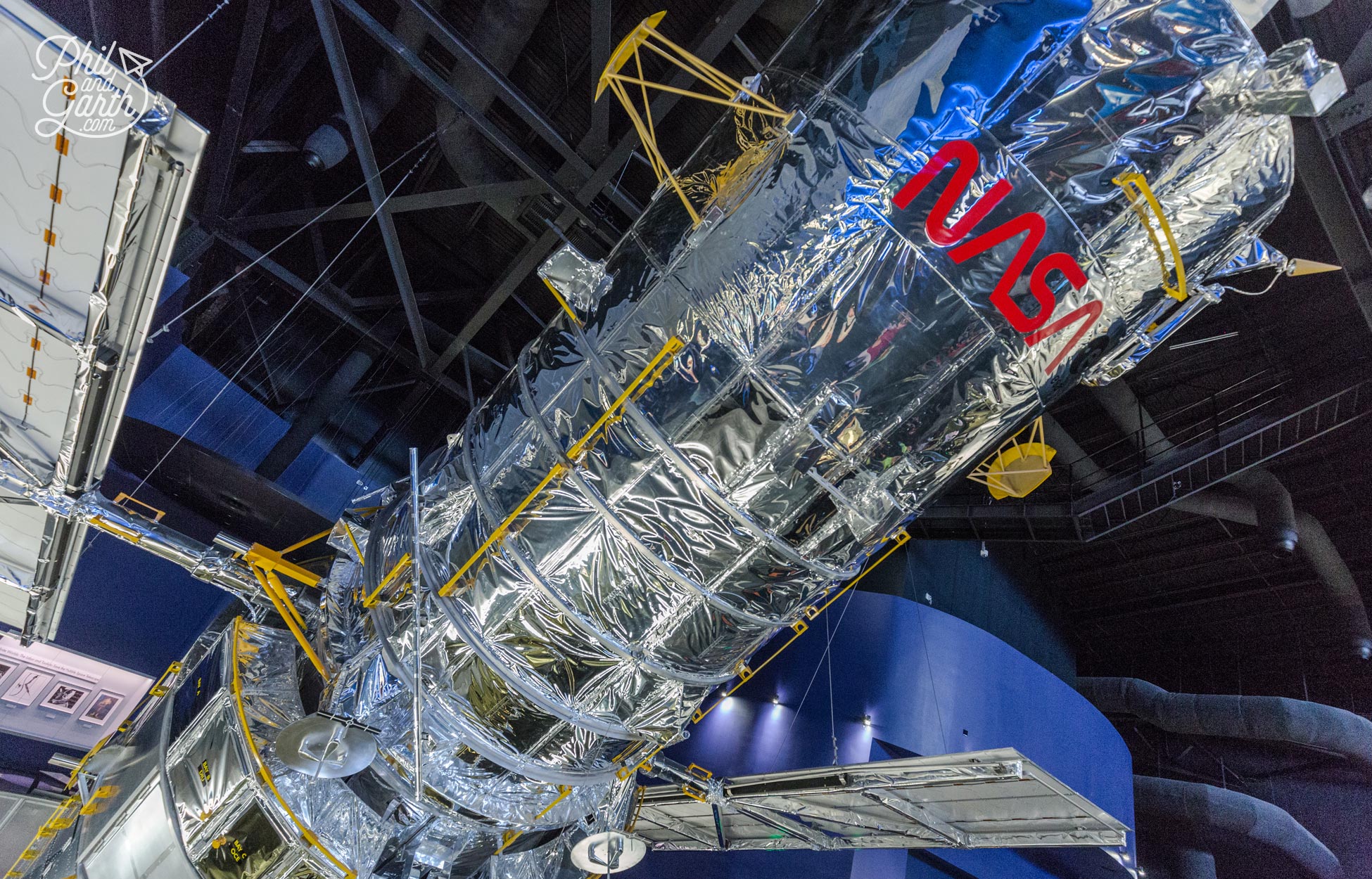
There’s a full size replica of the Hubble Telescope
There’s also a full scale replica of the Hubble Telescope suspended next to Atlantis.
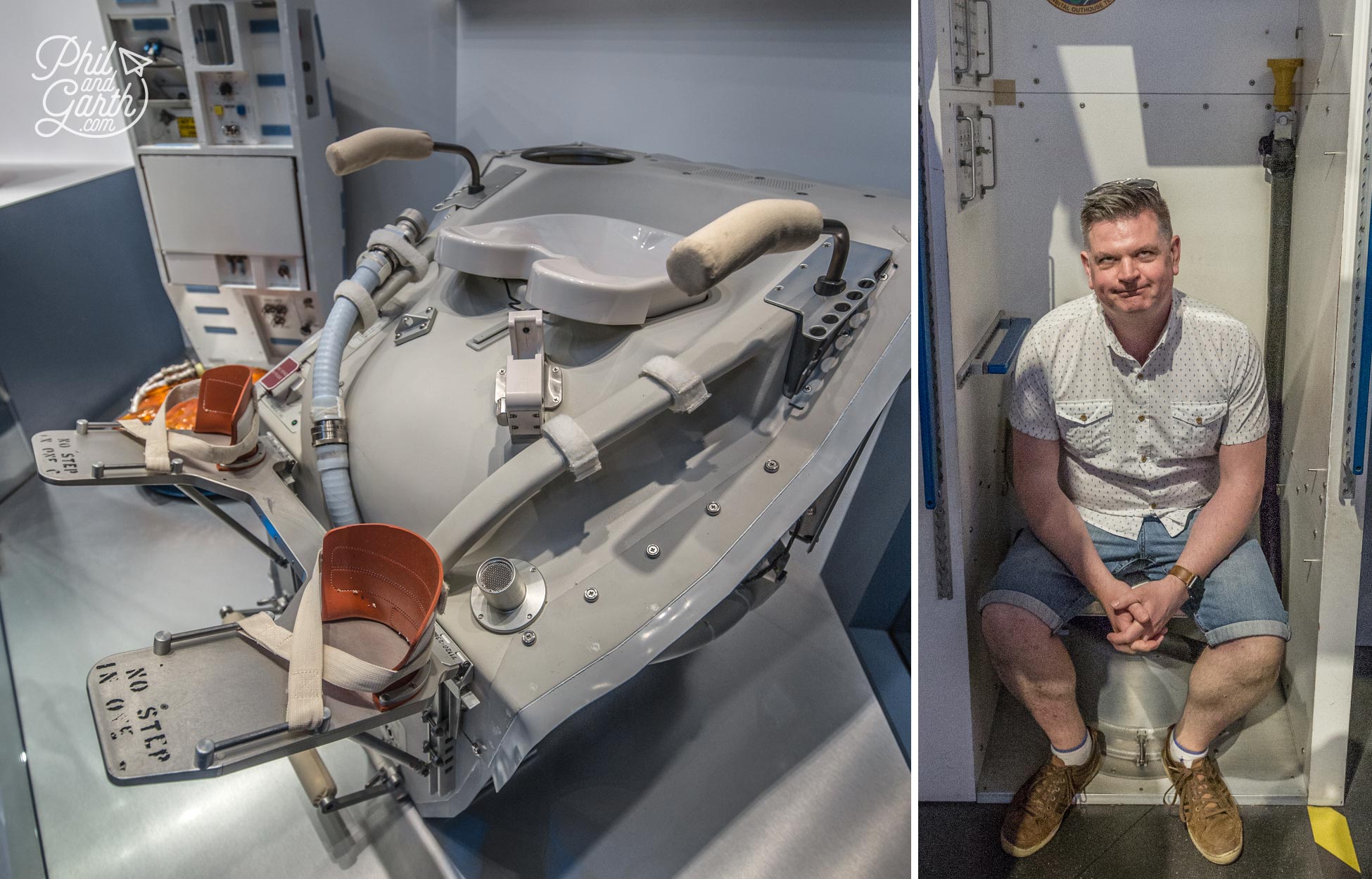
Even the space toilets are on display!
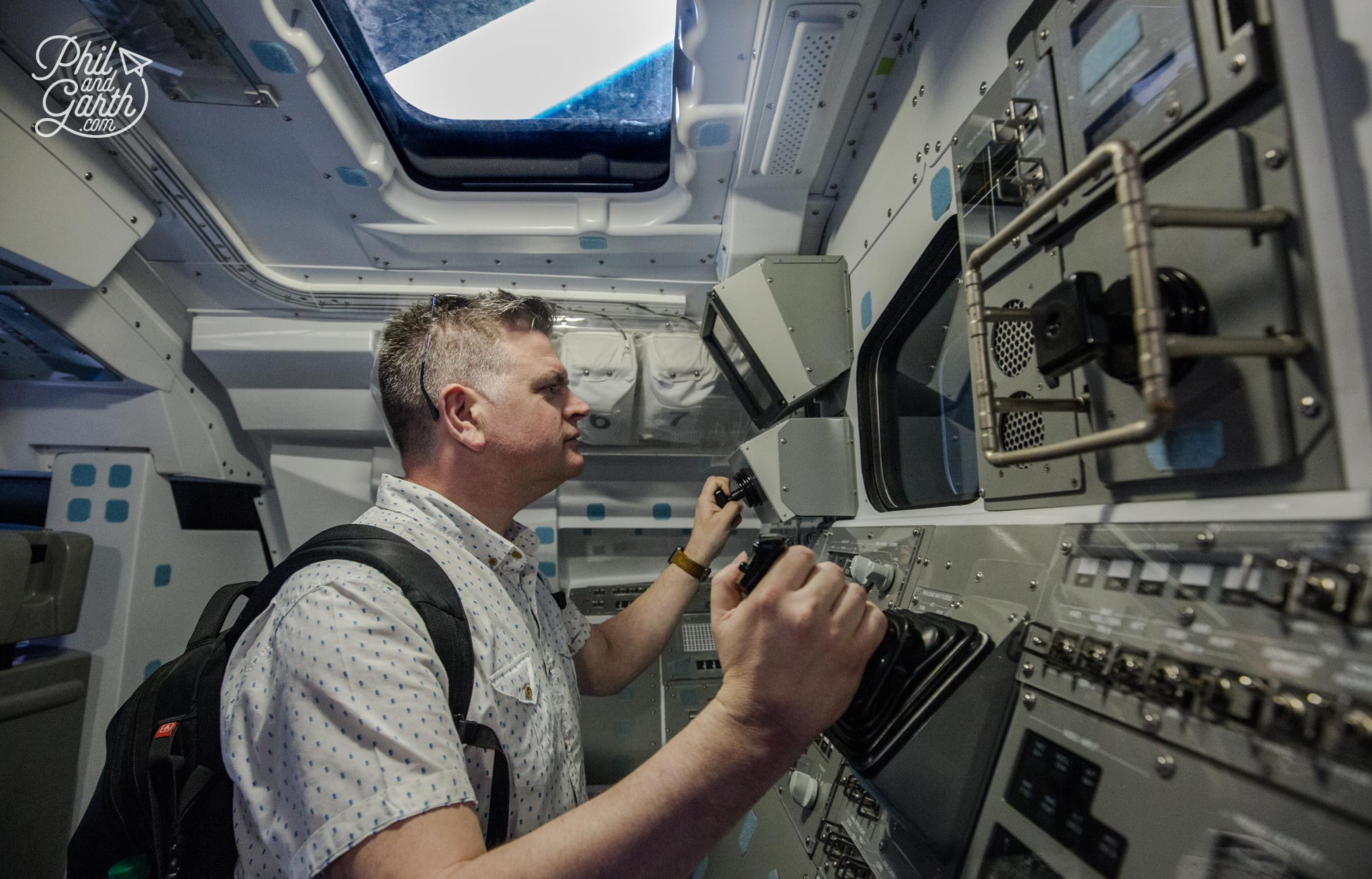
Phil at the Space Shuttle controls
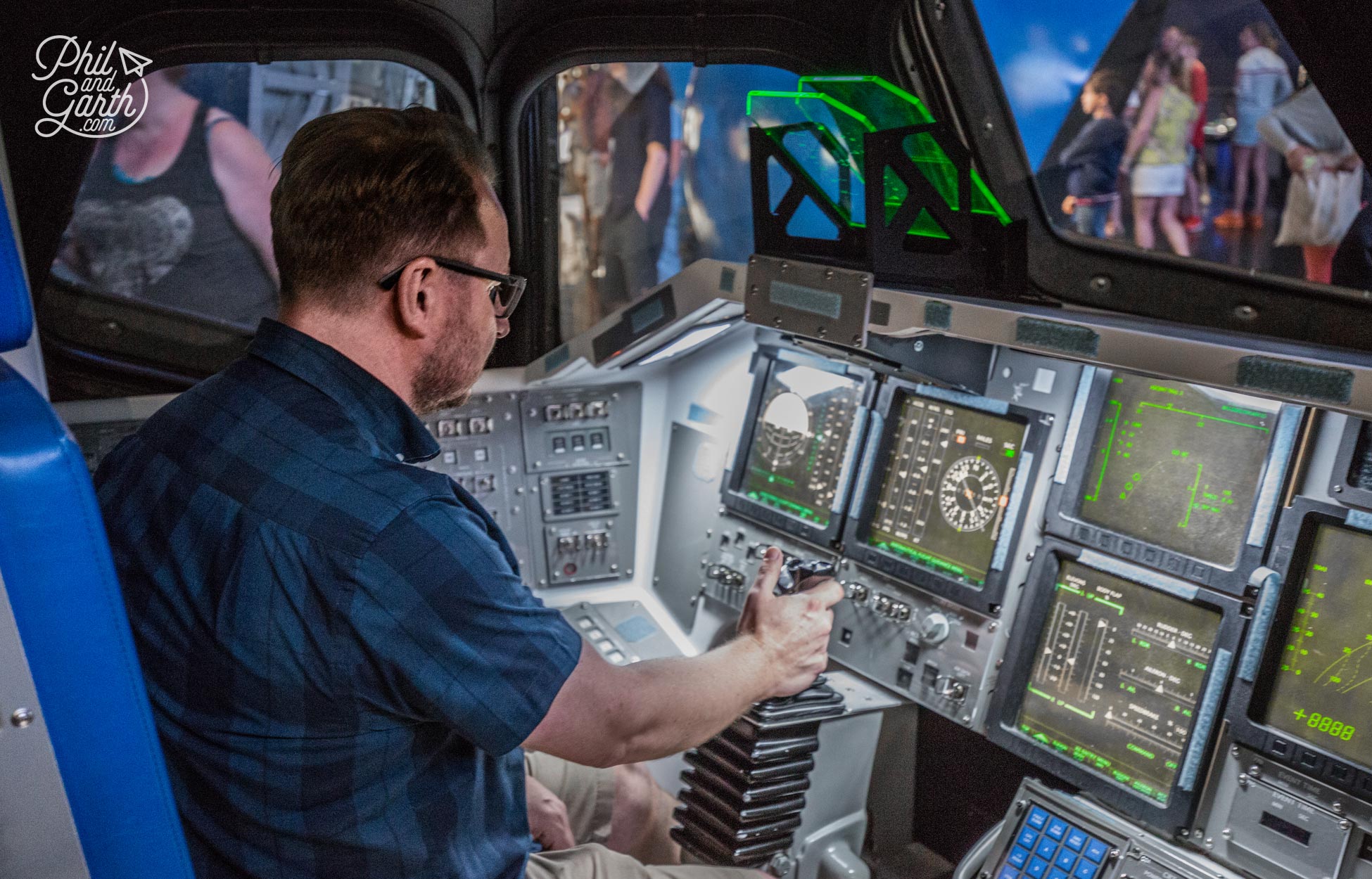
Garth practising his best landing technique
There’s lots of interactive exhibits that make you feel what it’s like to be an astronaut, plenty to keep kids (and big kids) entertained.
Seeing Space Shuttle Atlantis was amazing, but we both talked about witnessing the tragedy of Challenger live on TV in 1986, we paid tribute to them and their bravery in the memorial gallery here ‘Forever Remembered’ which honours the 14 brave astronauts who lost their lives on both Challenger and Columbia.
4. Shuttle Launch Experience
Before you leave the Atlantis exhibit there is a theme park style simulator ride – The Shuttle Launch Experience where you buckle up to see what it feels like blasting off into space at 17,500 MPH in 8.5 minutes! The rumble and shaking felt a bit rough and uncomfortable at times but we guess that’s what it would have been like for the astronauts! You’re not allowed to take any belongings onboard, so free lockers are provided.
5. IMAX Theatre
There are 2 x 45 minute films – ‘Journey to Space 3D’ all about NASA’s achievements and ‘A Beautiful Planet’ which we chose to watch. It’s a powerful documentary about climate change and astronauts living onboard the International Space Station, it’s a great insight into their lives. The best part are the stunning images of Earth filmed from the ISS, so big, so beautiful and breathtaking it’s the next best thing to being in space! Grab some popcorn before entering and enjoy the ride! Oh and the Kennedy Space Center website has trailers for each film, so you can decide on one before you go.
6. Nasa Now + Next
In this smaller exhibition space there are temporary displays of vehicles on loan from NASA and its partners. We saw Boeing’s CST-100 Starliner – a crew vehicle pressure vessel and the Moon Express test vehicle which will be sent to the Moon to mine for natural resources.
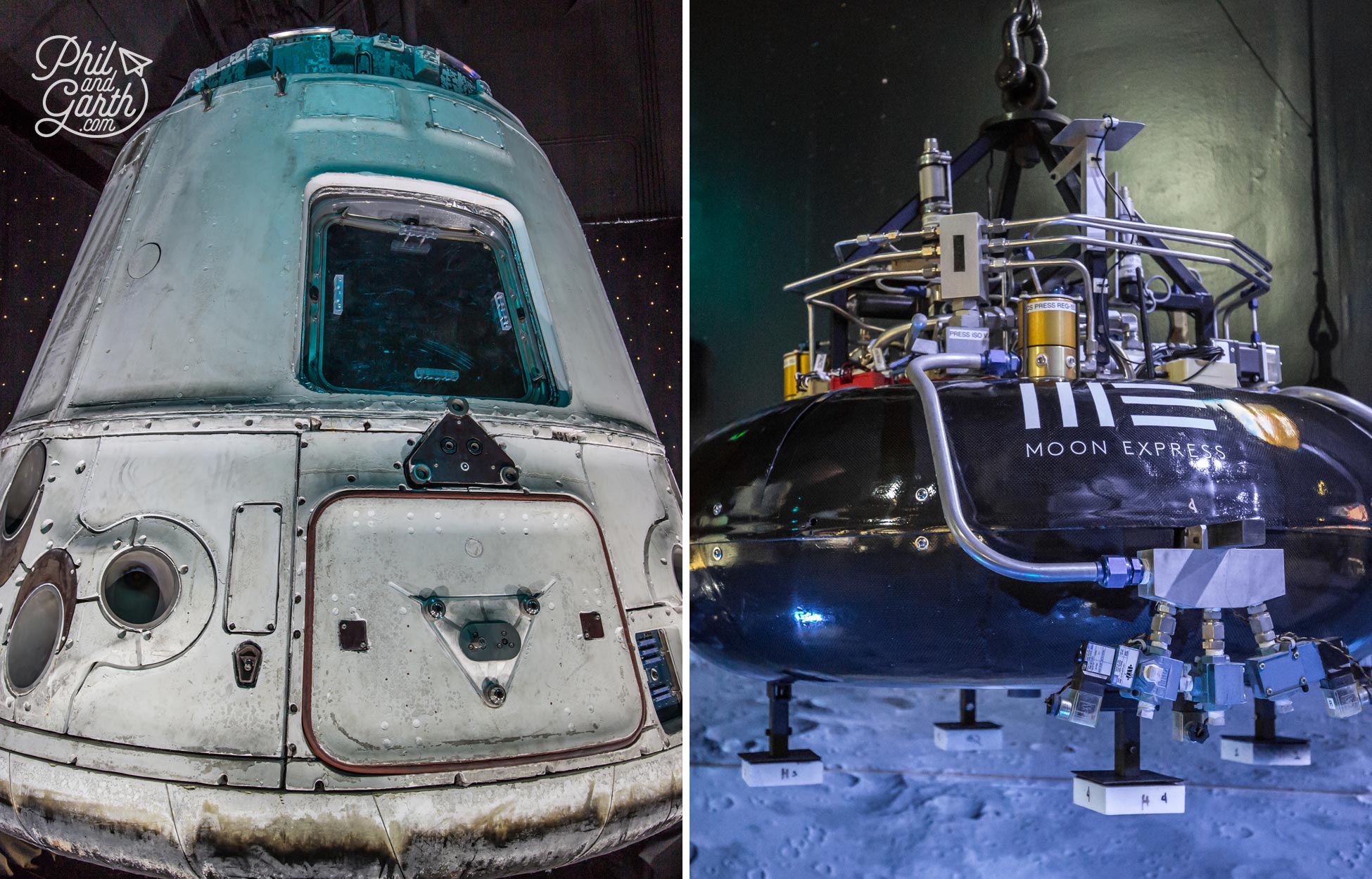
NASA Now + Next exhibition space
7. Meet A Real Astronaut
Oh and did we mention you can meet a real life astronaut! Either at ‘Astronaut Encounter’ inside the Universe Theatre or you can meet the ‘Astronaut of the Day’ at the huge gift shop for his or her autograph.
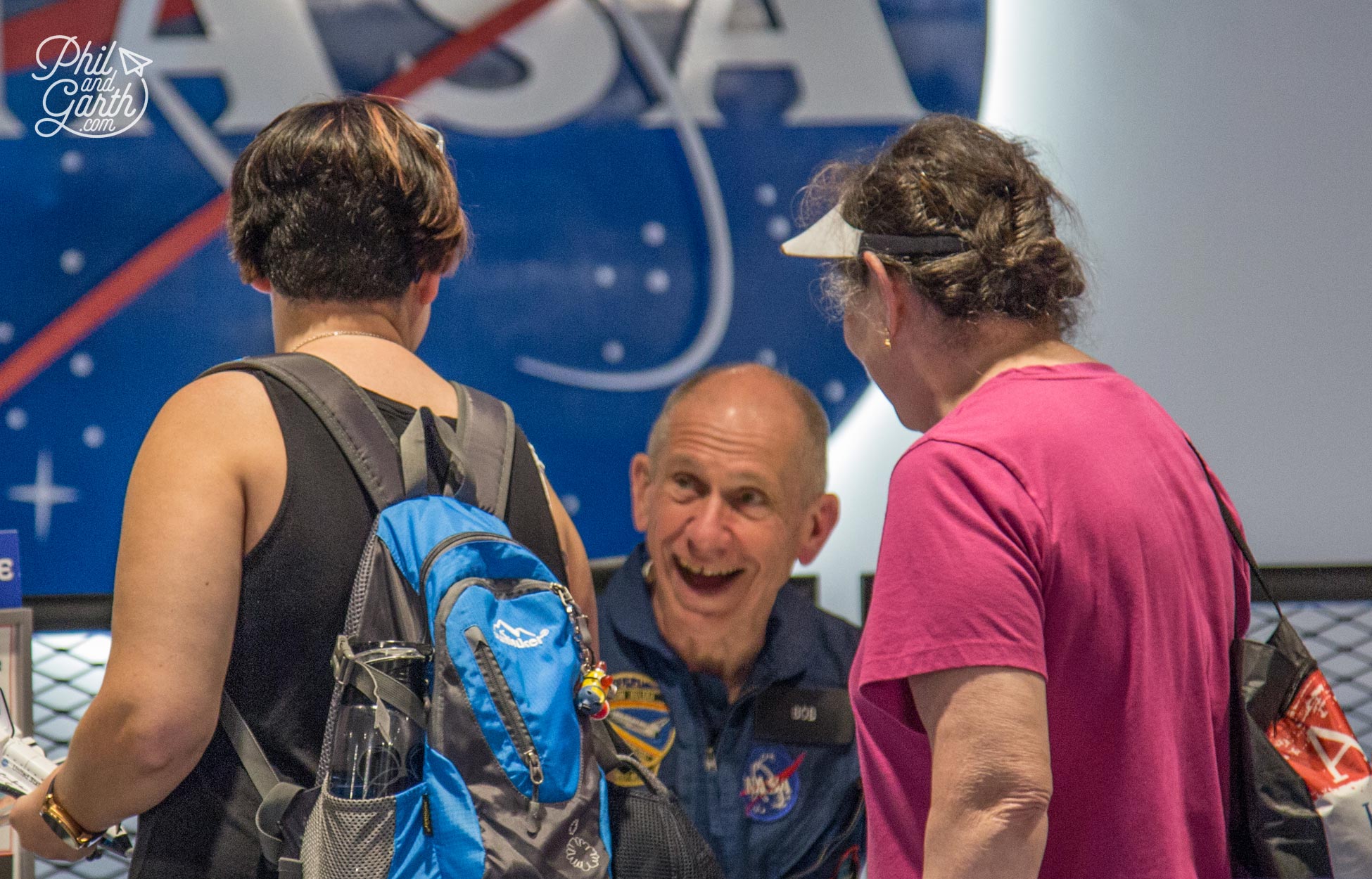
Visitors getting an autograph from Bob Cenker – a real life astronaut!
8. Journey To Mars Explorers Wanted
Journey to Mars is quite nicely done, there’s various small exhibits and a live theatre and multimedia show designed to educate and inspire the next generation of kids. Kinda like a big pitch to join NASA as a future employee, didn’t really tell you loads about NASA’s plans for travelling to Mars, other than their goal is to send humans to the red planet by the 2030s.
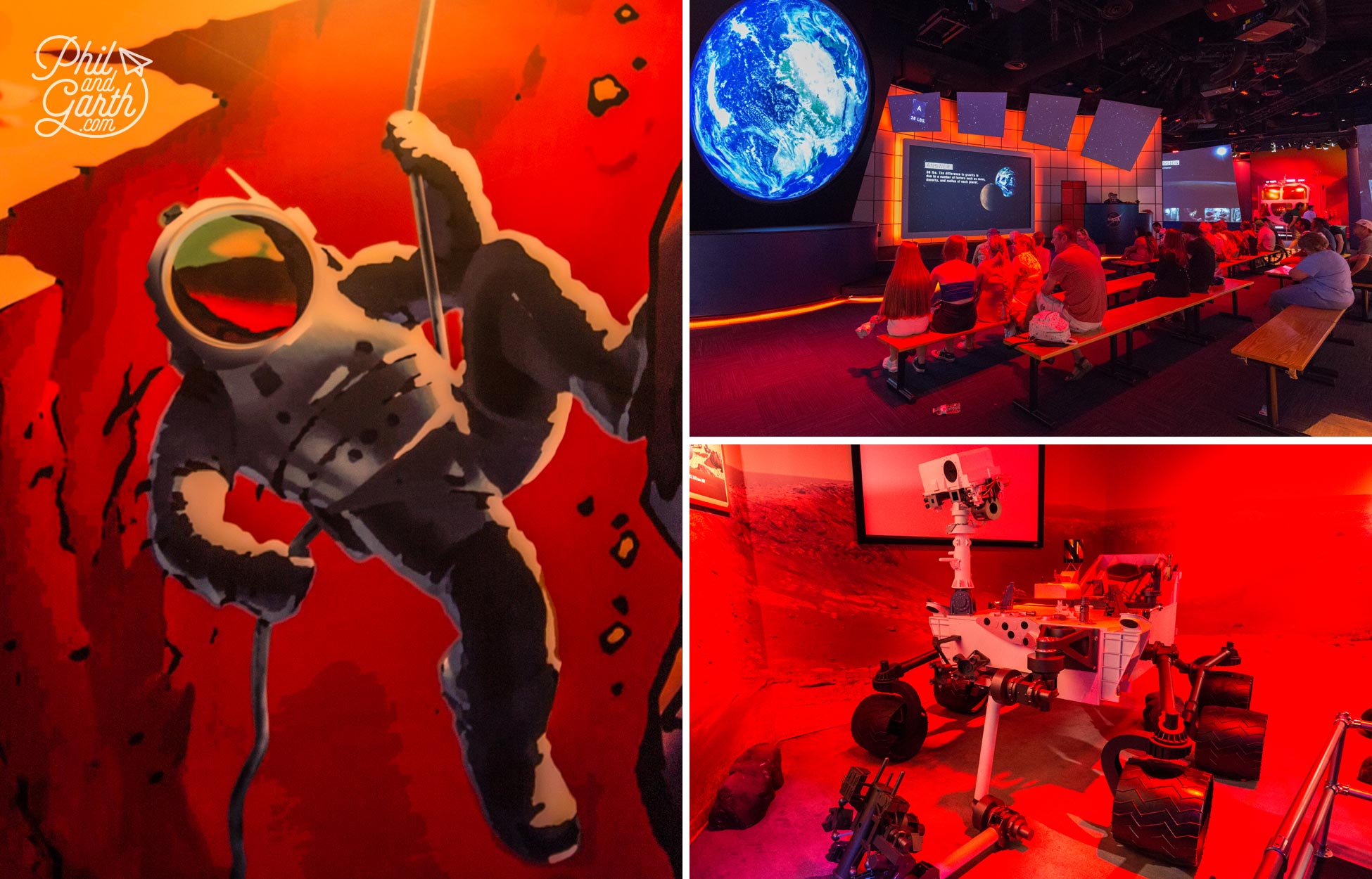
Journey to Mars Explorers Wanted
9. The Rocket Garden
We liked walking through the Kennedy Space Center Rocket Garden where all the rockets are real (but have never flown). Our favourite was the smaller Mercury-Redstone 3 which in 1961 completed the first U.S. human space flight. There’s also a few replicas of NASA’s space capsules from the Mercury, Gemini and Apollo programs, Garth had a go in the Mercury one, a bit of a challenge getting in because it’s so small!
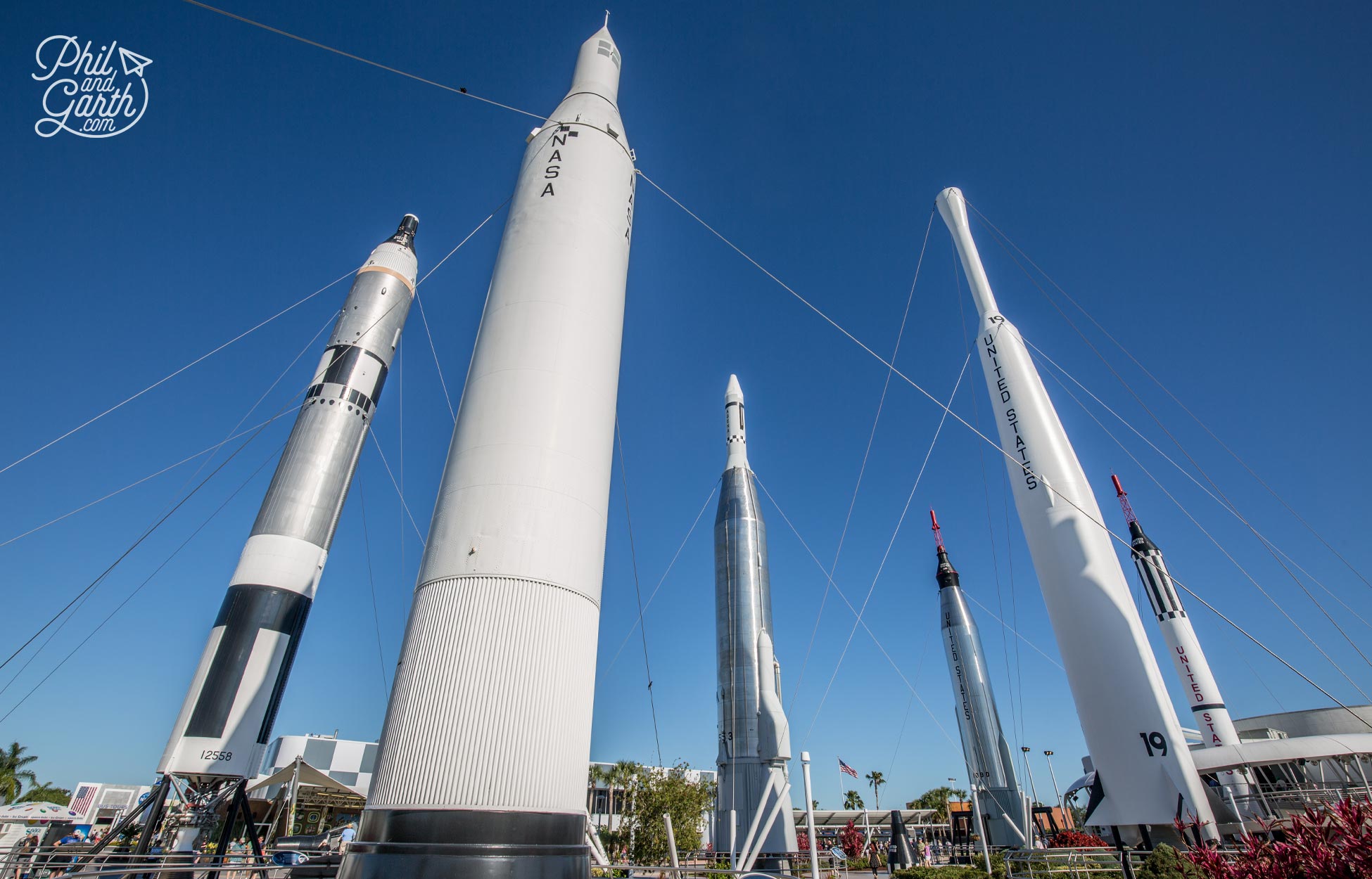
The Rocket Garden
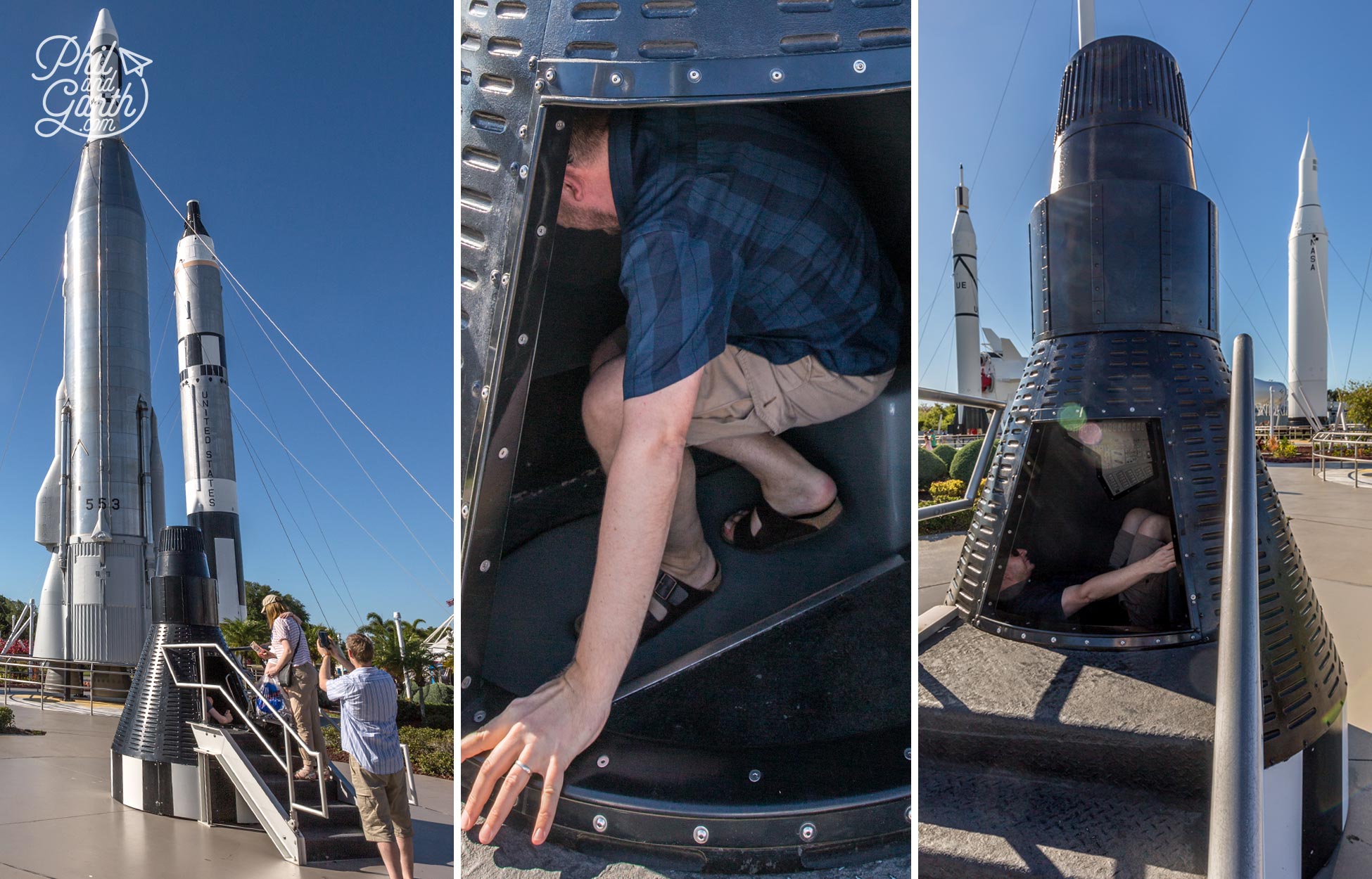
Garth checking out the Mercury capsule for size
10. Heroes & Legends
We finished off our day at the Kennedy Space Center with ‘Heroes and Legends’. This exhibit honours the men and women of the American space programs and starts with a video presentation posing a question to astronauts and the public “What makes a hero?”
Next up is the 4D Theatre experience which is excellent – tales of heroism, humanity and the spirit of adventure. Make sure you stand on the second or third their of the balcony for the best experience.
The Hall of Fame honours some of America’s space heroes, we thought there were only a handful of astronauts but there were hundreds – 338 to be exact, no doubt plenty more to come.
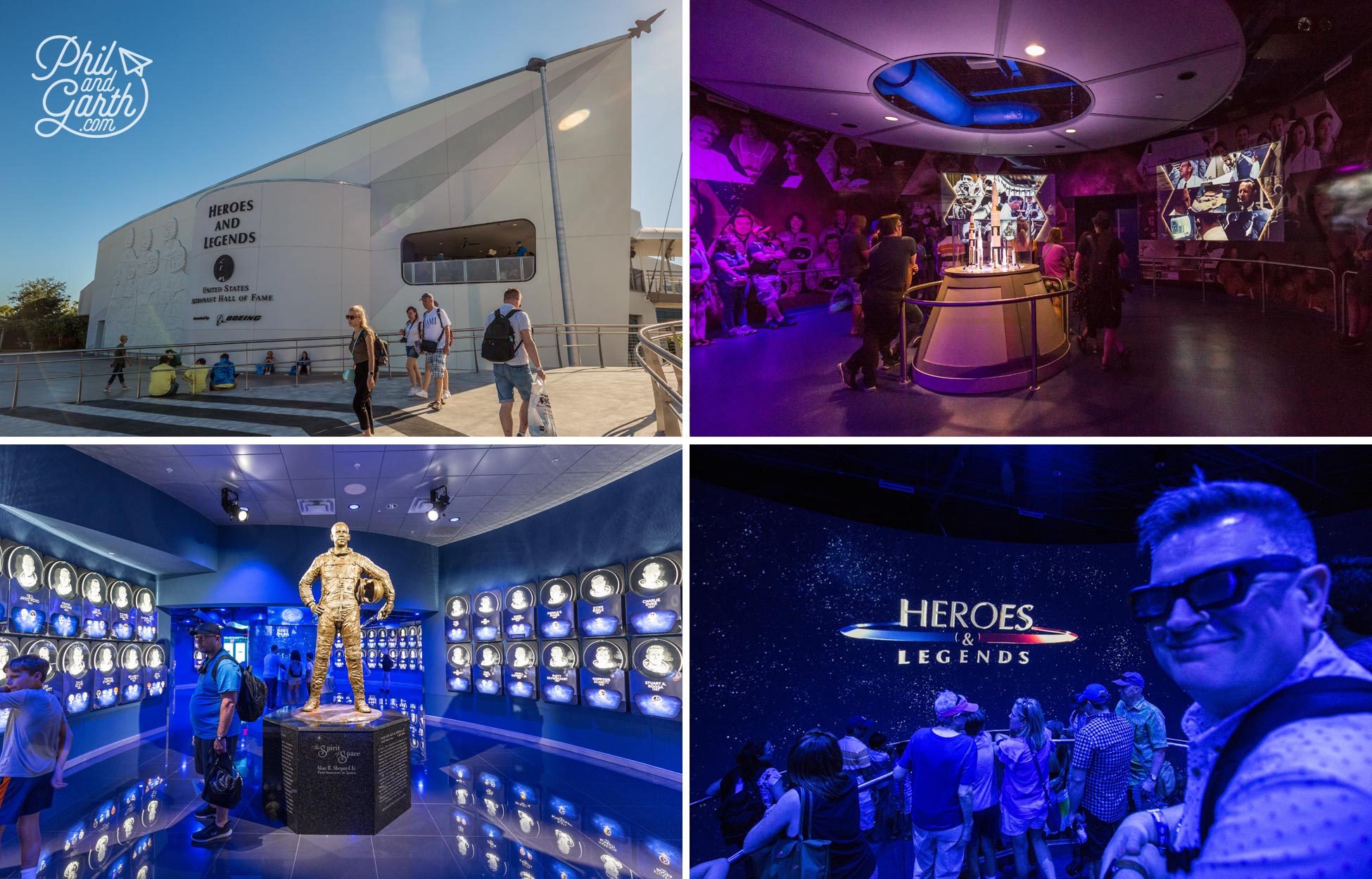
End your day at Heroes and Legends
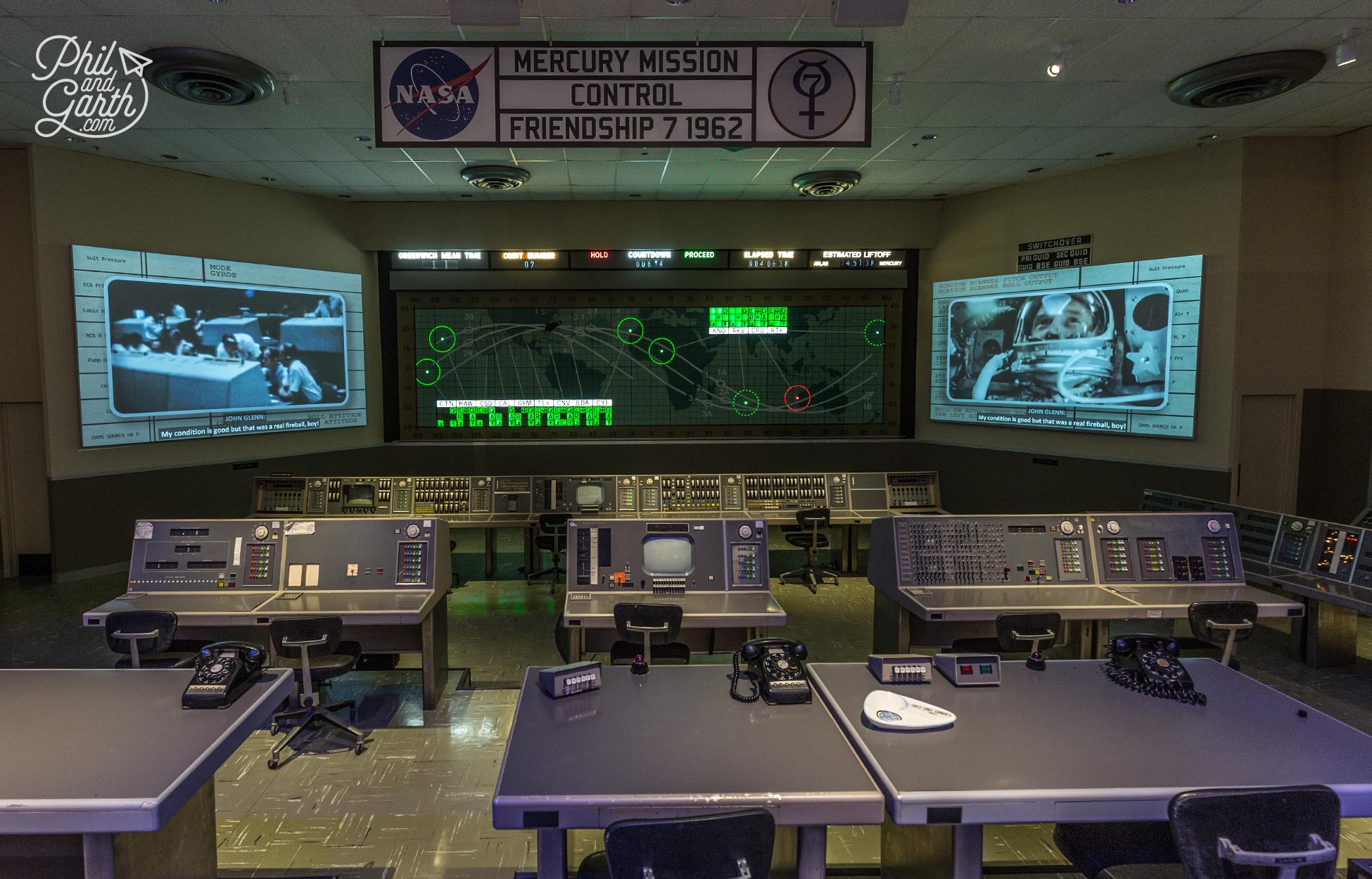
Recreation of the Mercury mission control room
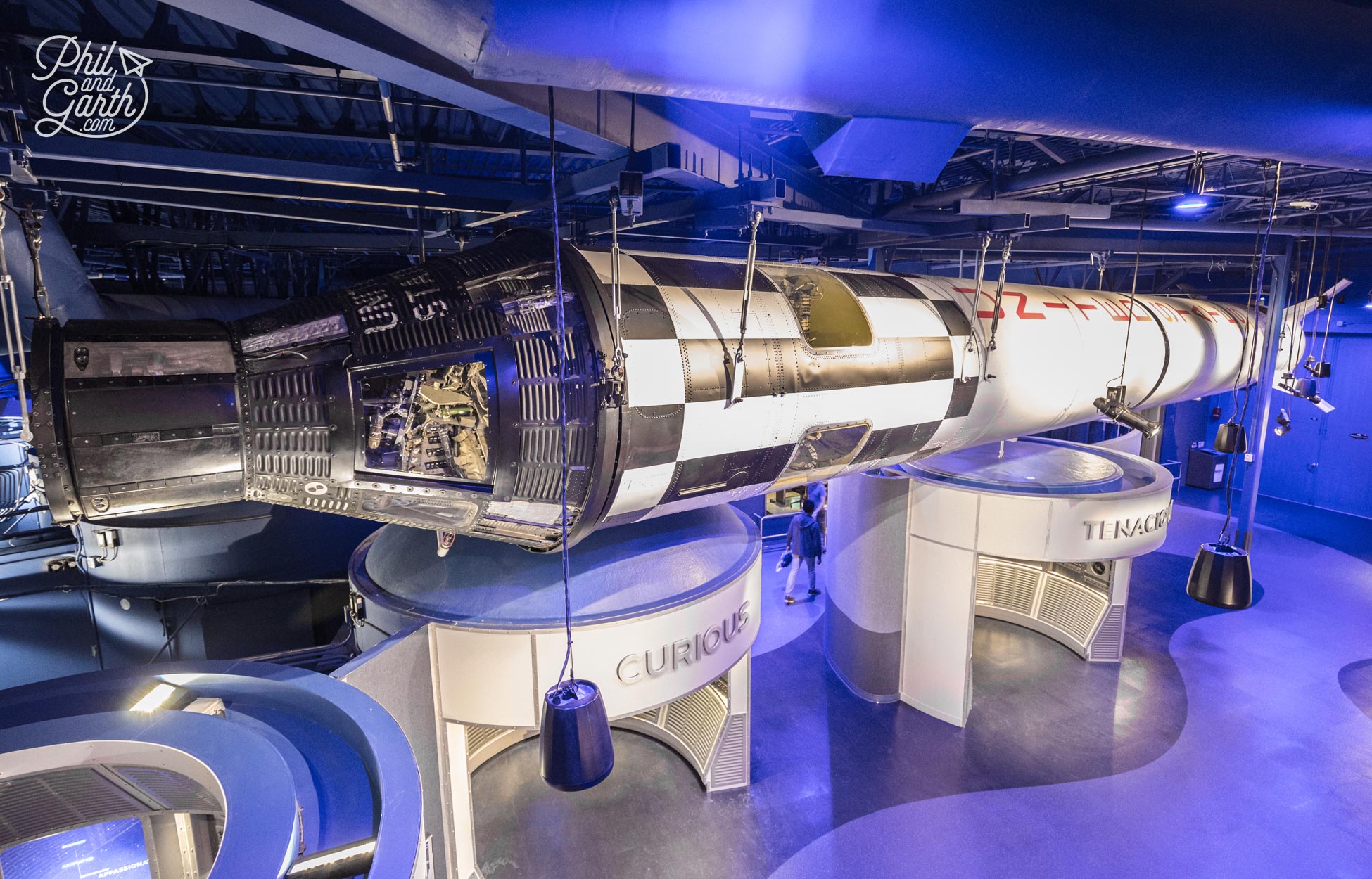
The Mercury Atlas ‘Horsepower’ Rocket
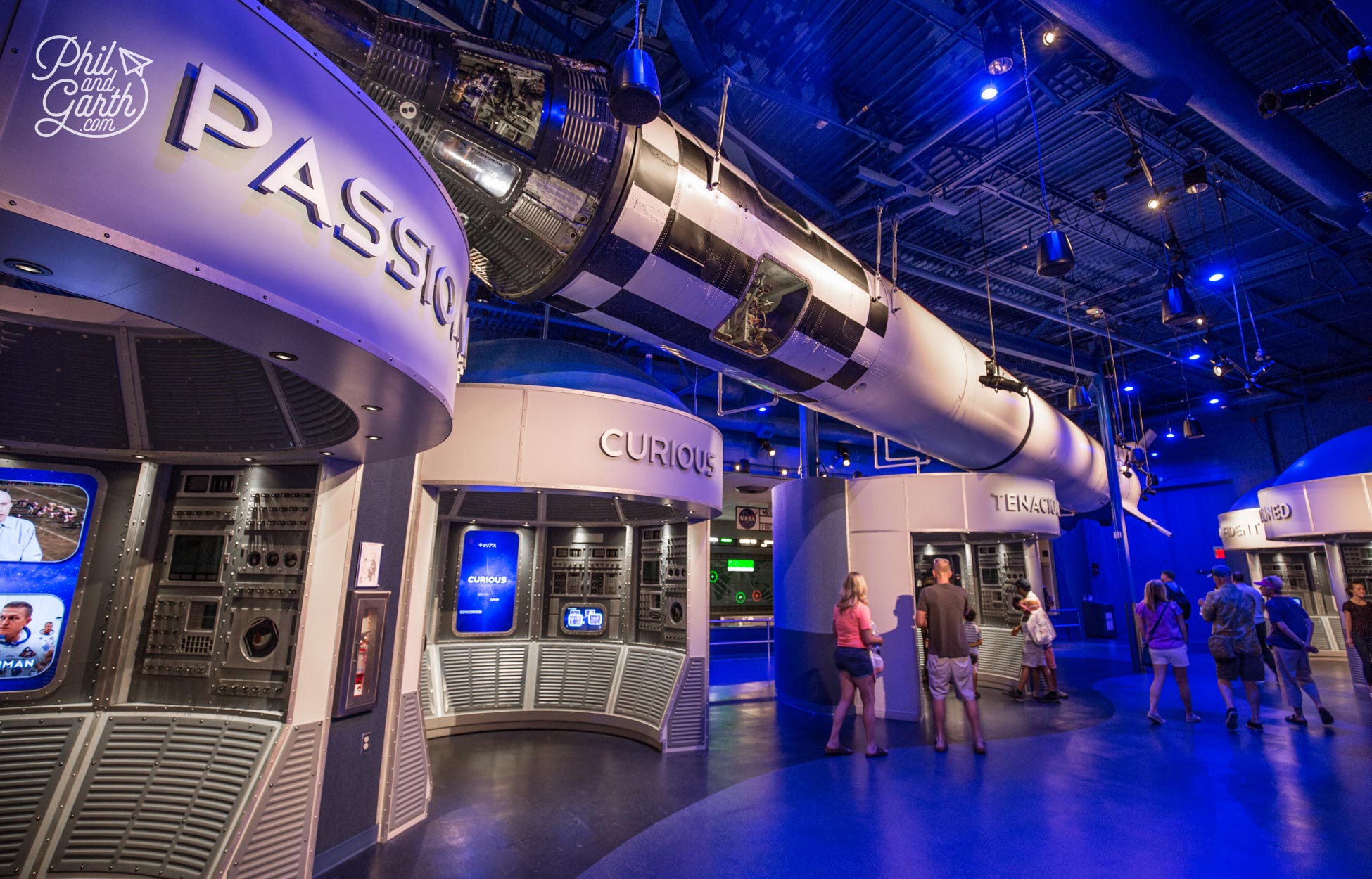
A hero is passionate, curious, tenacious, inspired, confident, disciplined, principled, selfless and courageous
Finally 9 different pods display the different qualities that make up a great astronaut. Each pod has different memorabilia which are quite inspiring to look at.
Our timeline summary of NASA’s achievements in Space:
- Mercury 1958-1963 – NASA’s first human spaceflight with a goal to put a man into Earth orbit
- Gemini 1961-1966 – First 2 man crew, their goal to develop techniques and technology for the Apollo missions.
- Apollo 1961-1972 – The Moon Landing program, their mission to land a human on the moon and return.
- Skylab 1973-1974 – The worlds first space station owned by NASA, occupied for 24 weeks.
- Space Shuttle 1981-2011 – First time a spacecraft was designed for reuse on multiple missions.
- ISS 1998-Present – The International Space Station, a joint research laboratory with worldwide space agencies.
- Artemis 2017-Present – ‘Moon to Mars’, NASA is sending humans to the Moon by 2024 and to Mars in the 2030s.
NASA’s Iconic Countdown Clock
Take one last photo before you go – next to the car park is the iconic countdown clock, we are ‘go’ for launch!
Garth next to the iconic clock that displayed countdowns to launches
We loved the Kennedy Space Centre as it lived up to our expectations and beyond, a big bucket-list experience ticked off. Whilst it may have a theme park feel about the place, it’s not really as the exhibits are unique. Even if you have no interest in Space you can’t help be impressed by the history of the human spirit and bravery to explore the unknown. Plus the enormity of the science and engineering that was required to go into space. 8 hours flew by and to be honest we would have liked to spend another day to see absolutely everything and do it more leisurely. For an even bigger bucket-list experience then why not time your visit and witness a rocket launch?
Disclaimer: We received two complimentary day tickets to The Kennedy Space Center. As always all opinions are 100% our own, this is not a paid sponsored post.
Kennedy Space Center Practical Information & Useful Advice
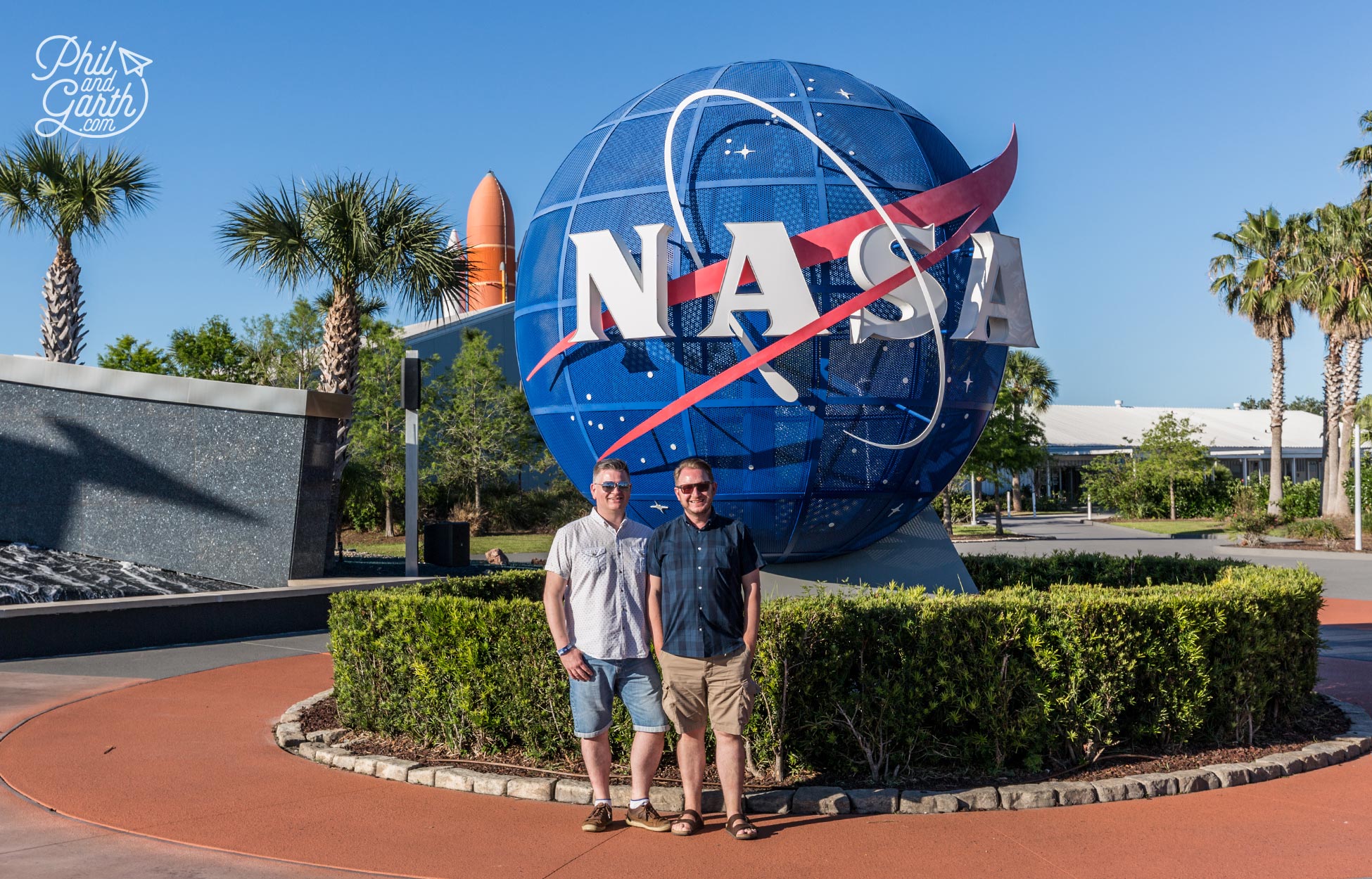
Phil and Garth at NASA’s Kennedy Space Center
Phil and Garth’s Top 5 Kennedy Space Center Travel Tips
- Tip #1: Arrive early to make the most of your day – we got there at 8.30am (we visited end of April).
- Tip #2: On the Bus Tour sit on the right (when seated looking forward) for the best views.
- Tip #3: You’ll need suncream and sunglasses in the fierce Florida heat.
- Tip #4: Avoid 12 noon for lunch and try eating later or earlier for smaller queues at cafes.
- Tip #5: Get in the mood and watch Apollo 13 (1995) and First Man (2018) before you go.
Kennedy Space Center FAQ
- What is the nearest airport to the Kennedy Space Center? MCO – Orlando International Airport is 45miles away.
- What time zone is the Kennedy Space Center? GMT -5 hours. Eastern Time Zone.
- What currency is used at the Kennedy Space Center? United States Dollar (symbol: $)
- What language is spoken at the Kennedy Space Center? English.
- How many people visit the Kennedy Space Center per year? 1.7 million.
- What number should I call in an emergency? Dial 911 for police, ambulance and fire brigade.
- What plug type is used in the USA? Plug type A & B. Voltage is 120V / 60Hz.
- When is the best time to visit the Kennedy Space Center? January to May and September to November.
- When is the worst time to visit the Kennedy Space Center? June to October because of regular thunderstorms.
- What is the Kennedy Space Center famous for? Sending the first human to the moon.
- What is the history of the Kennedy Space Center? Since 1968 The Kennedy Space Center has been the launch site for every U.S. manned space flight.
- What are the 5 must see sights of the Kennedy Space Center? Vehicle Assembly Building, Apollo/Saturn V Center, Space Shuttle Atlantis, IMAX Theatre and the Rocket Garden.
- What is the local dish? Burger and space fries.
- What is the best way to get around the Kennedy Space Center? The visitor centre is designed for walking.
- What’s a fun fact about the Kennedy Space Center? The Vehicle Assembly Building is world’s 4th largest structure by volume.
- What movies have been filmed at the Kennedy Space Center? Scenes from Contact (1997), Apollo 13 (1995) and Tomorrowland (2015) were filmed here.
- Where is the best photo spot at the Kennedy Space Center? The Rocket Garden.
- Where is a hidden gem at the Kennedy Space Center? The original countdown clock.
- What is the best souvenir to buy at the Kennedy Space Center? A spacesuit from the souvenir shop.





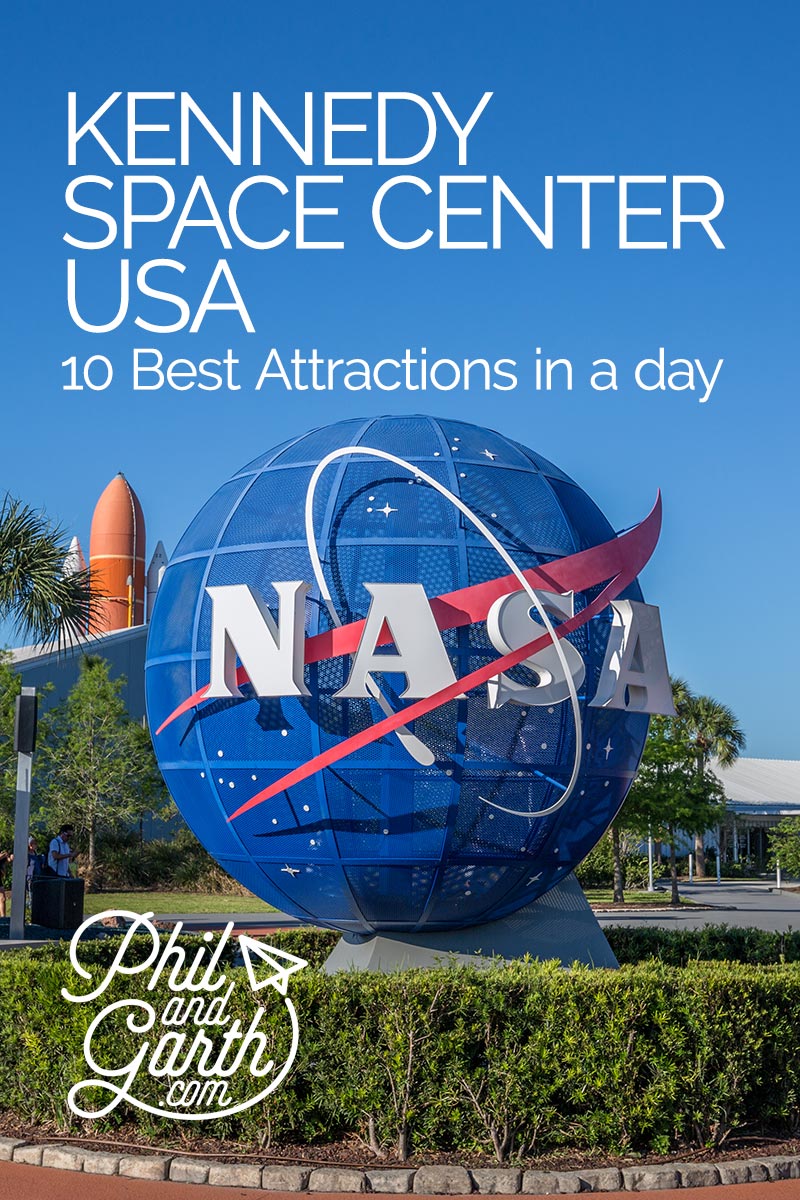
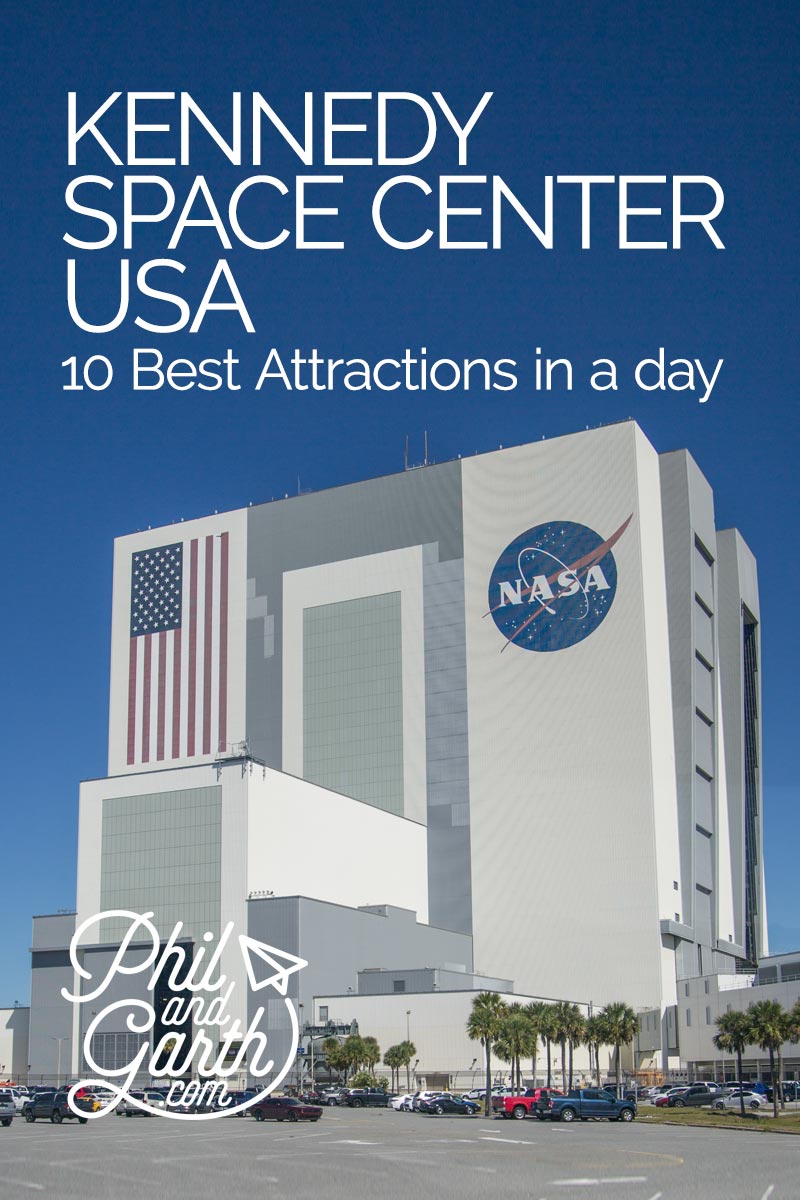
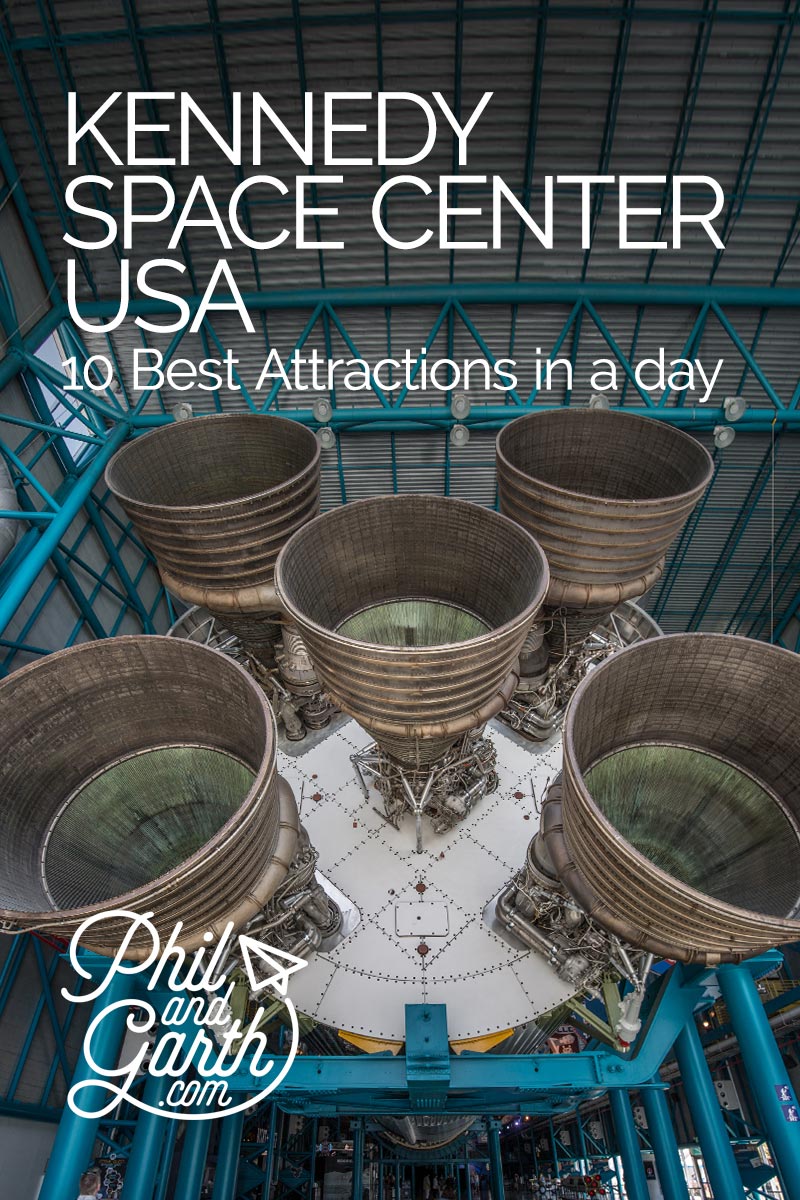
5 comments
Far out, it’s huge! I don’t think a 60-second video has ever convinced me to go somewhere before I’ve even read the article before. Nice job, guys! I get what you mean about the low-tech gear. The space suits look like costumes for a school play but then again it was the 60s and I can hardly remember them. LOL! This would never have been on my list to visit but it definitely is now. I want to see that Rocket Garden.
Everything is SO much more vast than I imagined! I would love to visit and see the actual space shuttles. I hope to visit someday!
The scale of everything is what I notice the most. Everything seems massive! Who knew that the space centre is a wildlife preserve as well? I would love to take my kids here one day. #FeetDoTravel
I’ve been here once before and enjoyed it very much. So much to see and the history is amazing. My partner and I plan to visit again in Sept, Reading this post makes me remember just how much I love it here!
So cool!! We’ve been to several of the NASA installations now. While there are some similarities, each one is unique as each played (and some still play) a different role in the space program. Space Center Houston – the “control center” for many missions – is one of our favorites, but you can’t beat all of those rockets and launch vehicles at Cape Canaveral! Now that you’ve ticked Canaveral off your bucket list, what’s next? Are other space sites in your sights?